Much of South East Asia is already very well explored.
Everyone knows about Bangkok, Bali and the Vietnamese coastal route (although it’s still very easy to get off the beaten track in these places!). But somewhere that’s not given nearly enough credit is Laos. Laos does have a position on the ‘banana pancake trail’, but it is poorly represented.
Many travelers in Laos just go to the UNESCO world heritage site of Luang Prabang, the hedonistic Vang Vieng, and Vientiane – the country’s capital. Now, I’m not saying that these places aren’t worth your time – although I don’t know if I’d return to Vang Vieng, but I’d encourage people to make their own mind up there – but there is so much more in Laos.
The south is much quieter than the north – it’s amazing to be in South East Asia and not be constantly amongst hoards of tourists – and there are spots in the northern mountains that see virtually no foreigners. It’s very easy to get off the beaten path in Laos.
But nonetheless, many travelers and backpackers in Laos want to see the country’s highlights as well; there’s a reason why so many travelers visit them, after all. I spent January 2019 in the country putting together this jazzy Laos itinerary, with all the tips and tricks you need to enjoy your time in the country.
This one month in Laos itinerary (which can be cut to create a 1 week, 2 week or 3 weeks in Laos itinerary, I’ll go into that in detail later) takes you through all of the best places in Laos, including some really off the beaten path Laos attractions and the more touristy places. And yes, there’s even a stop in Vang Vieng.
So buckle in, grab a mug of ginger and lemongrass tea (it’s all I’ve drank for the last month) and read about the very best places to spend up to one month in Laos!
How to get to Laos

As mentioned, many people incorporate their trip to Laos in a longer South East Asia trip – sometimes following the banana pancake trail. So most people fly into Bangkok and travel to Laos from there; you can reach most major cities from either Bangkok or Chiang Mai in northern Thailand.
From Bangkok, you can take a train to Nong Khai and cross the border to Laos, or there are direct buses. There are also direct buses from Chiang Mai to Laos. Laos is also accessible overland from Cambodia, Vietnam, China and Myanmar. It sits so snugly in the middle that I find it surprising that it’s skipped over so much! You can also fly into Vientiane.
As you may or may not know, I heart overland travel, so I can’t advise too much on flights; but I know that Vientiane serves most local destinations and Pakse and Luang Prabang have some international flights. You can book transport around Laos by using Bookaway. Click here to see times and prices.
Visas for Laos
Most countries get a 30 day visa on arrival at Lao borders and airports. The cost for this ranges from $30 – $42 if you’re Canadian (sorry guys). My visa on a UK passport was $35. You’ll need a passport photo of yourself – an extra fee applies if you don’t have one. The visa on arrival process is pretty painless and self-explanatory.
Health and Safety in Laos
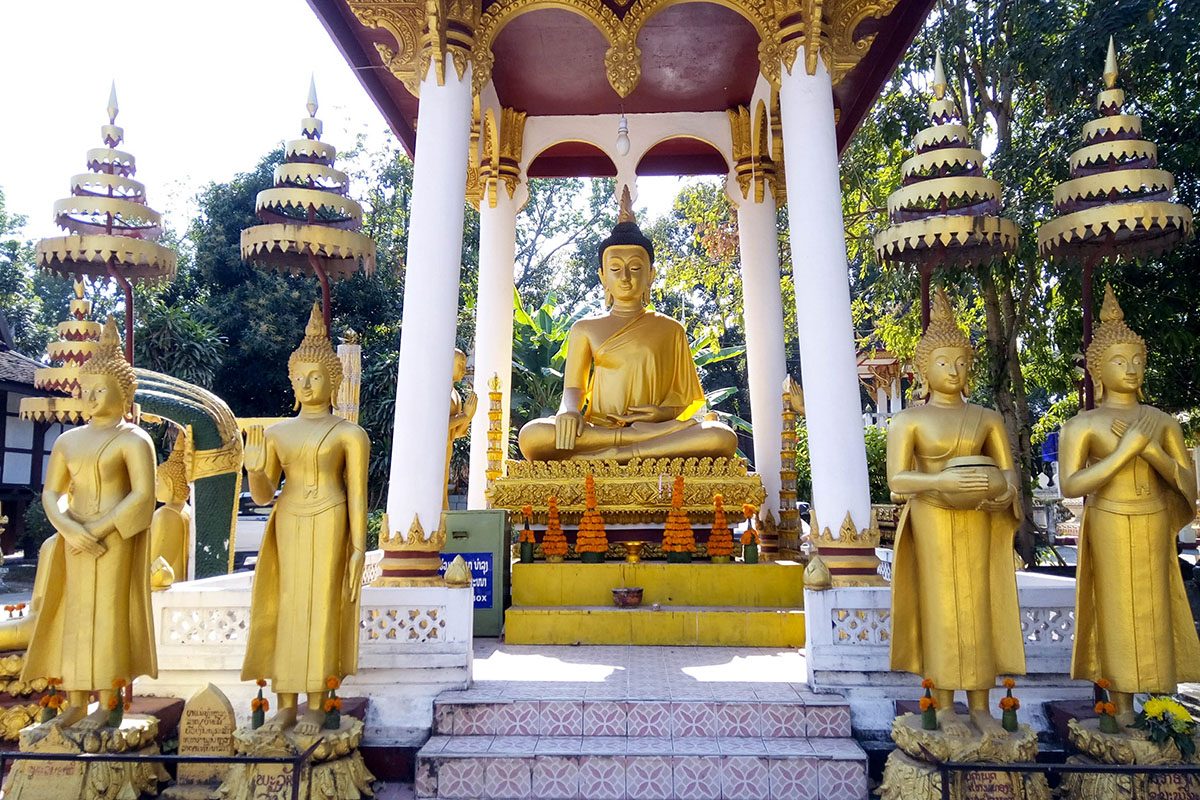
Laos is SO socially safe. Like, if I was dining alone and left my phone on the table while I went to the bathroom, it would probably still be there safe. (Disclosure: If you try that, I take no responsibility for what happens. I’m just trying to illustrate how safe it is).
The people are lovely and I didn’t go anywhere which had a dangerous feel. That’s not to say that pickpocketings don’t happen; I’m sure that they do. But on the whole, it’s suuuper safe. One thing that isn’t as safe is Lao roads. There isn’t really much you can do about this (trains don’t exist, at least not at the moment), but maybe take some travel sickness pills along with you.
If you’re worried, try not to travel at night (I never travelled at night, not because I wouldn’t have but because none of my journeys were long enough. One girl I met said she wouldn’t travel at night because of safety concerns).
Health, on the other hand, is a bit iffier.
You’ll need to make sure some vaccinations are up to date before you travel to Laos – check fit for travel to see what ones. Some people take malaria tablets (I did), and dengue fever is present so make sure that you use lots of mosquito spray.
It’s best to check with a travel doctor before you head to Laos to get some real medical advice (as much as I try to pretend I know all the illnesses, I really don’t and would hate to misguide anyone!). Minor illnesses are also common in Laos – due to poor food hygiene in some places, change in climate, just general travelling… I managed to contract the following, pretty much one after another (which was just lovely), while travelling in Laos…
- Esophagitis from swallowing a Doxycycline pill just before bed
- Earwax build up from wearing earplugs to bed every night (I had to get my ears syringed!)
- Food poisoning from eating room temperature food in the night market in Luang Prabang – check out some tips for dealing with travellers’ diarrhoea here.
- A weird cough/ dry throat/ cold from temperature changes
IT WAS SO PLEASANT.
This also means that I visited lots of doctors in Laos, two which I highly recommend. These were Alliance Medical Practice in Vientiane and Phakhan’s Clinic in Luang Prabang.
WiFi in Laos
I was actually very pleasantly surprised with the Wi-Fi in Laos. Sometimes it isn’t great, but in many places I stayed in it worked really well! Many people decide to boycott Wi-Fi and get their own Laos SIM.
I’m always averse to this, I don’t know why – I guess I just love being off the grid. Even when I spent 5 months living in Oaxaca, Mexico, I didn’t get my own SIM! But anyway, it’s very cheap to get a local SIM and they can be purchased from many stores and some hostels.
OR if you are flying via BKK (Bangkok), you could order a pre-paid SIM to collect there – so it’s ready to use as soon as you get to Laos. Click here if you want to learn more about this fab service.
Food in Laos
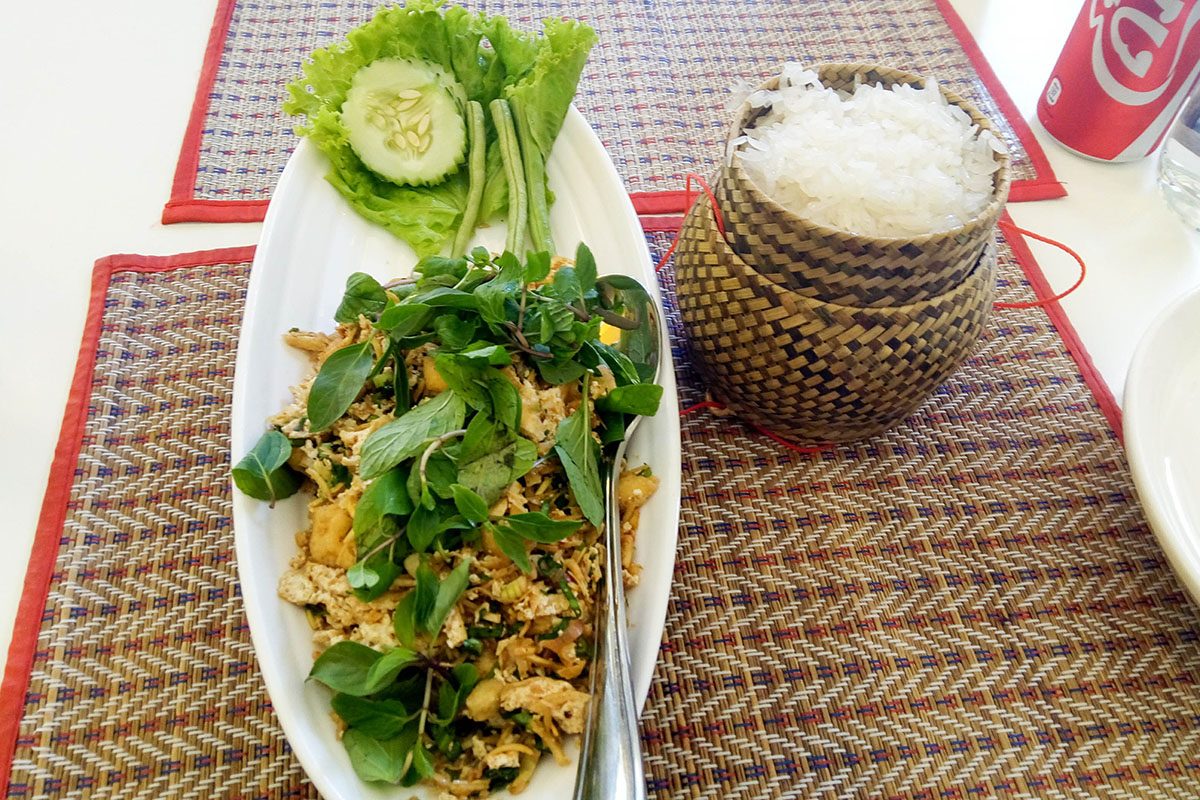
I found the food in Laos variable. A lot of it is very similar to Thai food; curries of different spice levels are popular here. There is also an unavoidable French influence, especially in the colonial cities; it’s the place in South East Asia to get a baguette (whod’a thought it?!).
Lao people eat more sticky rice than any other nation in the world, so many authentic Lao dishes will include this component. You just pick up rice from the container, mold it into a ball and dip it into whatever side dish there is, which can be anything!

There are also a lot of Indian people living in Laos, and we all know what that means… Indian food! There was at least one Indian restaurant in every city I went to. I found it quite easy to be vegan in Laos – I just asked for the vegetable curry with no fish sauce most of the time, or visited an Indian restaurant which are always vegan travellers’ all over the world!
I used Happy Cow to find recommended restaurants, and I managed to grab this delightful tofu larb (featured) in Vientiane. Larb is one of Laos’ traditional dishes, it’s a salad generally made with meat and herbs and served with sticky rice. I was really happy to find a vegan version and can confirm, it’s absolutely delicious!
How to travel around Laos
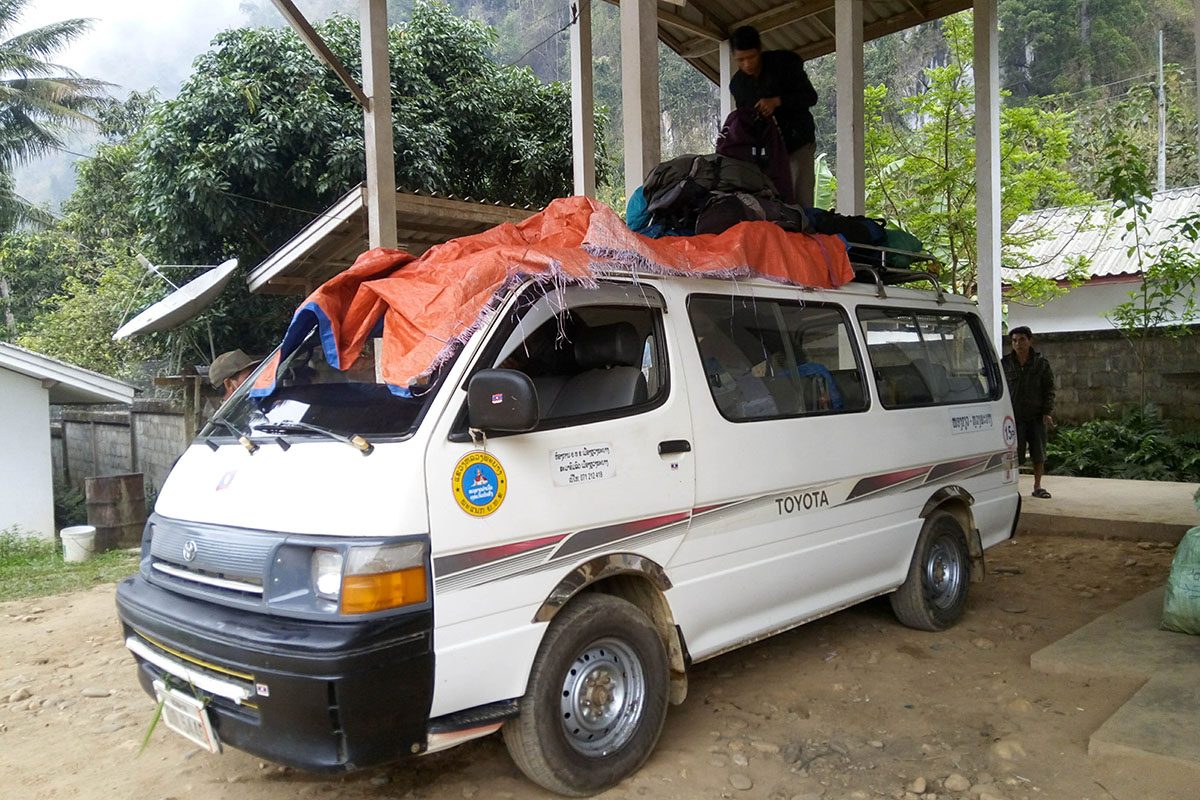
There’s only one feasible way to travel around Laos – good old buses. They’re an adventure in themselves – they generally don’t seem roadworthy and will leave you hanging on for dear life as they navigate bumpy roads and hairpin bends… oh, and they are always absolutely packed with people.
Lao buses actually have a fold-down seat in the aisle for each row, just to fit another person on! You can opt for VIP buses, which are more direct (although they do still stop sometimes) and are slightly more expensive. Or you can take local buses which stop absolutely everywhere, are fairly cheap, and take forever.

Buses in Laos can cost anywhere from 30,000 kip for a three hour local bus (I paid this from Savannakhet to Thakhek) to 110,000 kip for a sleeper VIP bus (this is the cost from Thakhek to Vientiane). The bus from Pakse to Vientiane, the longest direct bus in the country, costs around 270,000 kip. Once you’re in towns and cities, tuk-tuk is the general mode of transportation.
These are probably the most expensive thing about travelling in Laos, and quite often they will be set at a very inflated price which will be incredibly difficult to negotiate down.
I found Thakhek to be the worst for this. In smaller towns, like Nong Khiaw and Champasak, your own two feet are perfectly fine for transportation – everything is in walking distance. In Vientiane, there are some local buses which are good value. Click here to book transport on Bookaway!
When to Visit Laos

Much of Laos – unlike a lot of South East Asia – has very distinct rainy and dry seasons.
The rainy season generally runs from May to September, and I wouldn’t recommend travel to Laos during this time. Sure, you can still do things – but it rains a lot, many places are closed, and many others either inaccessible or very dangerous to access.
This is more noticeable in Laos than other neighbouring countries because the rainfall is heavier in these months and Laos has less infrastructure than Vietnam, Thailand and even Cambodia.
During the dry season, however, Laos is a dream.
From October to April, you’ll have very little to no rain, blue skies, and the temperatures will still be pretty warm.
In the highlands, they can drop during the night, but day temperatures, as a rule, remain quite high. It’s definitely one of the best places to visit in Asia in December and January.
If you visit in December, waterfalls will be at their strongest – and Laos has a lot of them.
I visited in January and enjoyed perfect sunshine every day. It does get a bit misty in the north during the mornings, but this generally clears by about 11am.
Where to Stay in Laos
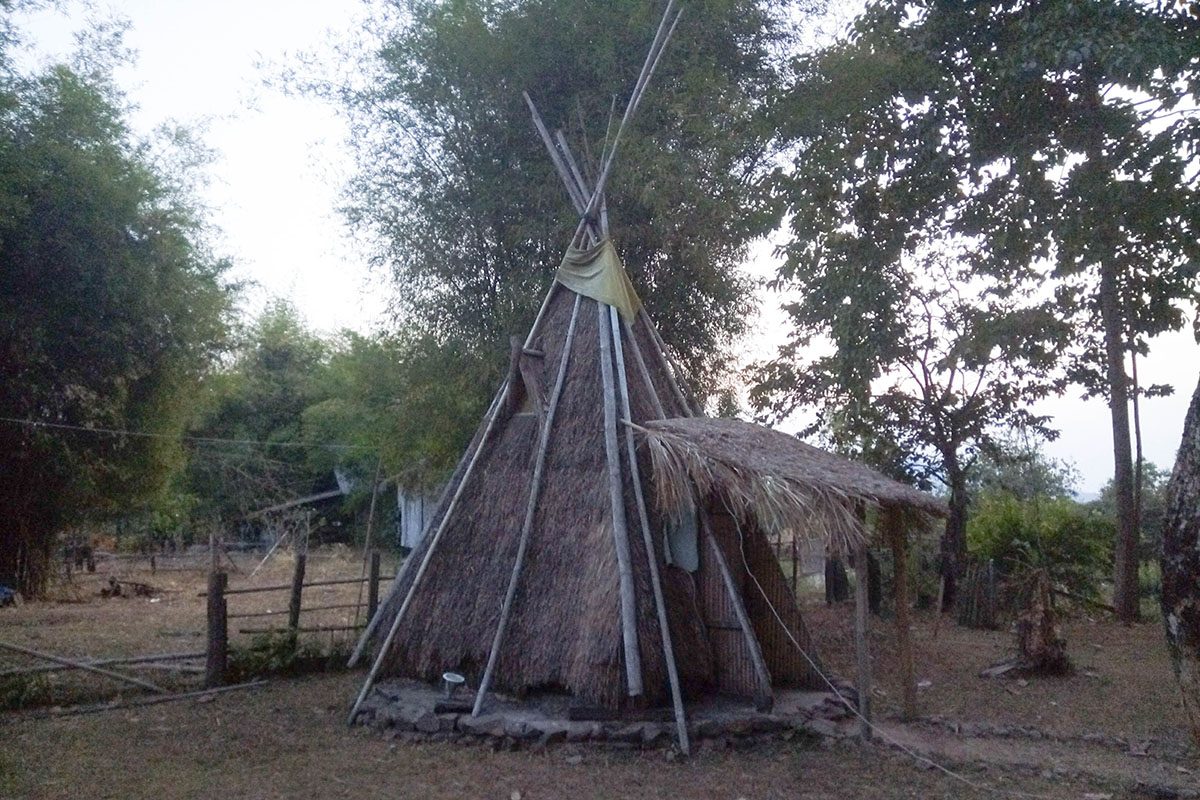
Laos only really has hostels in the main touristy areas.
So if you’re venturing off the beaten path, to places like Savannakhet, Kong Lor, Phonsavan and Nong Khiaw, you’ll be staying in guesthouses (for about the same price, so it’s all good). Lao guesthouses are normally pretty basic but clean – although many don’t have hot water.
It’s all part of the fun of travelling in this part of the world! In Vientiane, Vang Vieng and Luang Prabang, there are more luxury accommodations.
I’ve included hostel, guesthouse and hotel recommendations in each section of this post, but click here if you want to do your own research into where you might stay in Laos.
How long to spend in Laos
As mentioned, most citizens get 30 days visa on arrival at Laos borders (overland or airport). I’d recommend spending the entire one month in Laos – there’s loads to see, and it does take a bit of time to get around! But, understandably, some travelers are on more of a time limit.
If this is you, then one, two or three weeks in Laos might work better. This Laos itinerary focuses on one month in Laos, but if you have less time, think about doing one of the itineraries specified below.
One week in Laos
Luang Namtha – Nong Khiaw – Luang Prabang Luang Prabang – Vang Vieng – Vientiane (this is the typical ‘banana pancake’ route) Thakhek – Kong Lor – Vientiane 4,000 Islands – Pakse – Bolevan Plateau
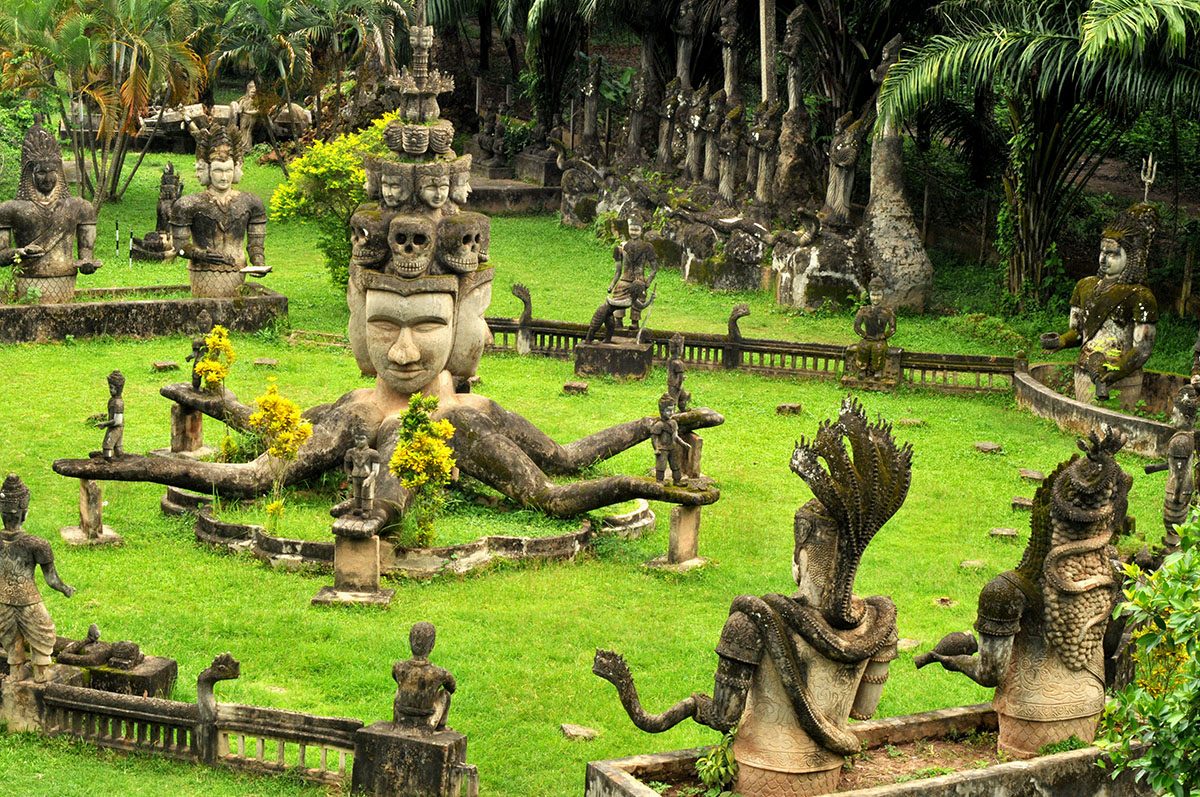
Two Weeks in Laos
Luang Namtha – Nong Khiaw – Luang Prabang – Vang Vieng – Vientiane Luang Prabang – Phonsavan – Vang Vieng – Vientiane Vientiane – Kong Lor – Thakhek – Pakse – Boleavan Plateau 4,000 Islands – Champasak – Pakse – Bolevan Plateau – Savannakhet
Three Weeks in Laos
Luang Namtha – Nong Khiaw – Luang Prabang – Phonsavan – Vang Vieng – Vientiane – Kong Lor – Thakhek – Pakse – Boleavan Plateau – 4,000 Islands
One month in Laos
My itinerary for one month in Laos will take you from north to south, hitting all of the best tourist attractions en route. The Laos itinerary includes:
- Luang Namtha
- Nong Khiaw
- Luang Prabang
- Phonsavan
- Vang Vieng
- Vientiane
- Kong Lor
- Thakhek
- Savannakhet
- Pakse
- Boleavan Plateau
- Champasak
- 4,000 Islands
and it’s not too rushed. So, shall we get into it?
Getting to Laos
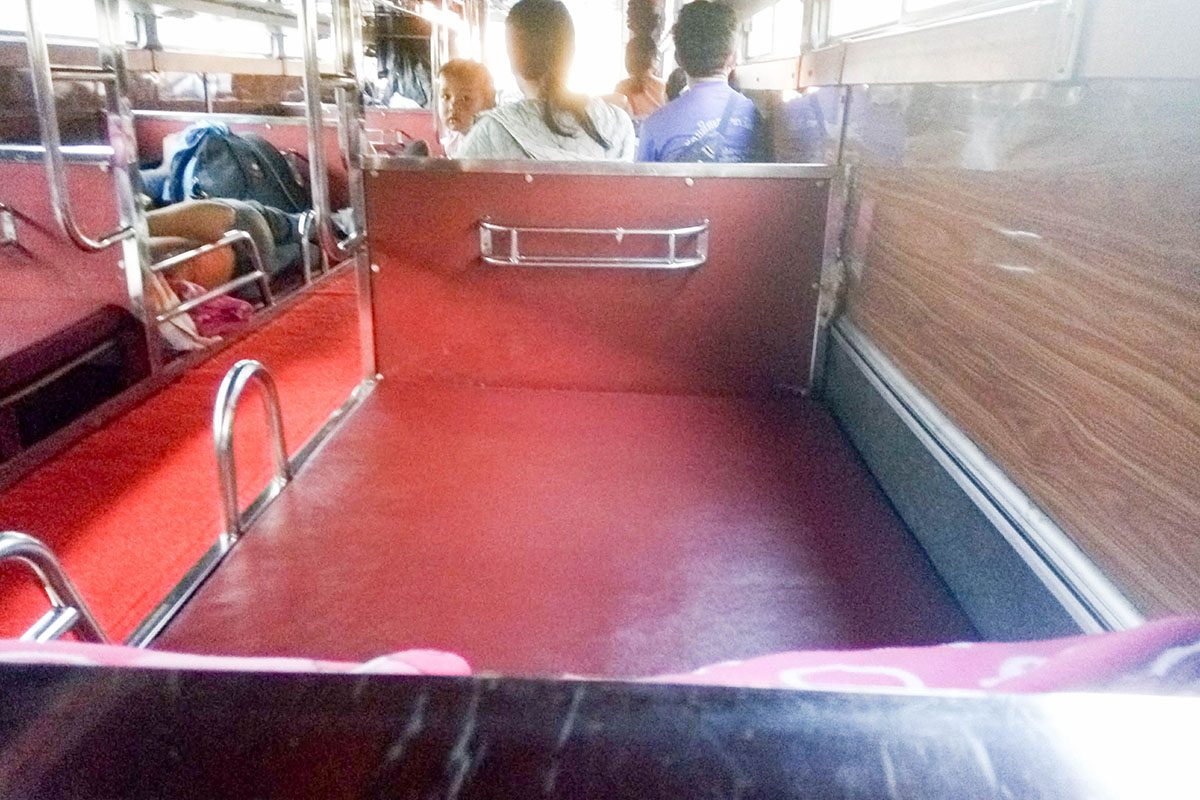
This Laos itinerary starts in the north of the country – imagining that you have crossed overland from Thailand. If this is you, you’ll want to book a bus from Chiang Rai or Chiang Mai to Luang Namtha.
This same bus will, however, go all the way through to Luang Prabang, so if you want to get off there and skip the north (which I highly don’t recommend, Nong Khiaw is one of my favourite places in Laos), that’s possible too. Of course, many people enter Laos via slow boat.
If you want to do this too and still follow this itinerary for Laos, you have two options. You could either take the slow boat from the border to Pak Beng and from there take a bus to Luang Namtha. This cuts your slow boat time in half – although many people have said that they would have been happy with just one day on the river. I guess it’s called the slow boat for a reason…
Your other option is to take the slow boat all the way to Luang Prabang, then take a bus to Nong Khiaw, another to Luang Namtha via Udomxai, and then take a bus back to Luang Prabang.
This method does involve a lot of backwards and forwards right at the start of your trip. If you don’t really want to do this (you will be spending a lot of time in buses during your 4 weks in Laos), then you could just visit Nong Khiaw as a side trip from Luang Prabang and cut out Luang Namtha.
You might also enter Laos from the south.
This is actually what I did – but most people I met were going north to south, so I thought it imperative to write it in reverse. If you book a bus from Siem Reap with Asia Van Transfer (book by clicking here), you’ll be guided through the crossing all the way to Don Det.
This is what I did and although a very long journey, it flowed pretty seamlessly. You can also take a bus to Pakse (where you can travel south to the 4,000 islands and then north again to the rest of the country) if you are entering Laos from south Thailand. And this Laos itinerary actually follows the border of Thailand for a lot of the way, so if you want to enter Laos in the centre of the country you can do so by crossing at Savannakhet, Thakhek or Vientiane.
Book transport to Laos on Bookaway by clicking here.
Luang Prabang – 2 days

Note: I’ve put Luang Prabang at the start of this Laos itinerary because it is where a lot of travellers first enter the country, whether they are taking a slow boat or an overnight bus from Thailand, or a long-distance bus from Vietnam.
However, if you are entering from China, Thailand or Vietnam and fancy an adventure, you might prefer to travel via the northern highlands and see some local villages – the routes are detailed below.
If you are taking the slow boat or a direct bus to Luang Prabang but still want to see the highlands, you can easily travel from Luang Prabang to Nong Khiaw and Muang Ngoy and then return to Luang Prabang before heading south. Luang Namtha is a bit more challenging, but I’ve detailed what you need to know below.
After Vang Vieng, Luang Prabang is the most touristy place in Laos. But unlike Vang Vieng (I’ll get into that shortly…), Luang Prabang is really quite charming. The city is filled with French colonial architecture and it is located on the Mekong. It’s a very religious city and the central area is a UNESCO world heritage site.
There are loads of things to do in Luang Prabang to spend a few days. If you’re taking a morning bus from the north, you’ll get to Luang Prabang at around midday.
If you’ve taken the slow boat from the Lao/ Thailand border, you’ll get there in the evening and be able to enjoy a full day the next day. I’d recommend spending your first day in Luang Prabang strolling around the city centre, checking out all of the architecture.
There are plenty of Wats to explore, as well as the Royal Museum which tells the story of Lao royalty and how it intertwines with Buddhist ideals.
After exploring these spots, head to Mount Phousi for a spectacular sunset – but try to get there about an hour before sunset as it is incredibly busy!
Mount Phousi is a very spiritual place for Lao people, so take some time to absorb the mystical feeling of it and of course, admire the spectacular view.
Follow this link to book a half day tour of Luang Prabang’s best sights.
For dinner, check out Tamarind. Specialising in set menus of Lao cuisine, and with plenty of vegan options, dining here is a must-do in Luang Prabang.
Do try and book during the day though, as they are often very busy and don’t always accept walk-ins. If they are booked or you fancy something a bit different, you could think about doing a Luang Prabang food tour – click here for more information and to book.
Day number two in Luang Prabang has a very early start.
Wake up at 4:30, ready to see the almsgiving at 5am. This is where the monks walk down the street and are offered different food and products. It really shows you how spiritual Luang Prabang – and all of Laos – is and is certainly one of the most unique things to do in Laos.
You can see the almsgiving independently, but to ensure that you get the best spot, to enable you to interact with the monks and to learn all about this sacred tradition, you could book on a local tour. Click here for more information.

Day tripping out to Kuang Si Falls is a must-do while in Luang Prabang.
These waterfalls are among the best in South East Asia and, although busy, are well worth it. Hire a motorbike to make the journey or book onto a minivan for around 35,000 kip return.

You’ll get back to Luang Prabang after lunch, and if you still have the energy think about taking a boat to the Pak Ou Caves. If you don’t want to go to the caves independently, you could book a tour that will take you to both the falls and the caves. Considering that you can only get to the waterfall by tourist shuttle or motorbike, this might be a good idea. Learn more about and book the tour here.
An alternative for your afternoon in Luang Prabang is a cooking class. There are a few cooking classes available throughout the city; click here to learn more about a highly rated class. You could also take a course at Tamarind – the place I recommended you eat at the night before. Click here to book it.
Upon returning, and maybe after a power nap (you did wake up at 4:30am after all!) head to Utopia. This bar offers yoga during the day and turns into Luang Prabang’s best club at night. They also offer food with a variety of Asian and Western options.
Be sure to stay here for some BeerLao after dinner! If you’re up for a big night out…. You won’t get it in Luang Prabang, sorry.
But what you can do is wait until Utopia closes at about 11:30pm, and then head to the bowling alley.
Yep, that’s right – the bowling alley in Luang Prabang is the place to be late at night (it’s the only place that sells alcohol past 11pm).
Watching a load of rowdy drunks attempt to bowl is an extraordinarily entertaining way to finish off your time in Luang Prabang!
Where to Stay in Luang Prabang
Hostel: Smile Luang Prabang Hostel is a great option for backpackers. With sturdy beds with their own individual light and curtain, good wifi and air conditioning, it is a fantastic place to stay in central Luang Prabang. Click here to book Smile Luang Prabang Hostel.
Mid-Range Hotel: Sanctuary Hotel Luang Prabang enjoys a central location, but is indeed a sanctuary, set back from the city. Rooms are air-conditioned and the hotel has free WiFi. Each room has a flat screen TV and safety deposit box, as well as an en-suite with warm shower. Click here for some information about Sanctuary Hotel and to book.
Luxury Hotel: Mekong Riverview Hotel is one of the best luxury options in Luang Prabang. With spacious rooms with a balcony and private bathroom (some with a spa bath!), massage facilities, a pool and a bar, you’ll be in the lap of luxury during your stay. An excellent breakfast is included. Click here for more information and to book.
Where to go from Luang Prabang
If you want to check out northern, off-the-beaten-path Laos, keep reading for a Northern Laos itinerary.
If you haven’t got time or don’t want to venture too far off the beaten path, click here to go straight to the Vang Vieng section of this Laos itinerary (this is what most travellers do), or click here to see what Nong Khiaw has to offer (this will require a return 3-4 hour journey to Luang Prabang, but I definitely advise you check it out – it was one of my favourite parts of Laos).
Luang Namtha – 1-2 days

Luang Namtha is beautiful and well worth the visit if you have enough time during your one month in Laos and don’t mind windy, long bus rides! It’s also a great stop-over if you’re entering Laos from Thailand and not taking the slow boat – you’ll pass through the town on the same bus.
Here’s the route from Thailand to Luang Prabang via Luang Namtha and Nong Khiaw:
Not many travellers come to Luang Namtha, which is shown in the lack of tourism in the region. T
his makes it a great place to get in touch with local life!
The main highlights of Luang Namtha can be enjoyed by driving a motorbike around the town and local villages.
You’ll get to see authentic village life, spectacular views like the one over the Sea of Rice and visit the Nam Dee Waterfall.
If you’re feeling really adventurous, you could drive the 64 kilometres along windy mountain roads (or take the bus, that’s totally cool too) to Muang Sing, which is very close to the Chinese border and about as remote as you get.
This is even more ‘authentic village life’ than Luang Namtha and has some equally spectacular scenery.
Where to Stay in Luang Namtha
In rural Laos (which is most of the country), there are less flashy hotels, and more basic guesthouses.
These are very kind on your wallet, and while basic, you can generally get clean, safe, comfy rooms.
Kingmala Guesthouse in Luang Namtha is a budget kinda place; its rooms are no-frills, but they provide an attached bathroom as well as comfy beds, good WiFi and air conditioning. The staff are friendly and helpful.
It’s probably your best bet in Luang Namtha whatever your budget – click here to read more about it.
Muang Khua – Muang Ngoy – 1 day

If you’re entering Laos from Vietnam and fancy a route a bit different to the direct bus to Luang Prabang, consider taking a bus frm the border to Muang Khua.
From here, you can take a boat down the Nam Ou river, through some of the ‘most dramatic scenery in the country’ (says Lonely Planet).
It takes six hours and seeing the water bordered by mountains is absolutely phenomenal. You’ll then be in Nong Khiaw, which has easy access to Luang Prabang.
If you’re in Luang Namtha and you want to add on the Nam Ou River boat trip, you might want to think about taking this route and then travelling by boat from Muang Khua to Nong Khiaw:
There isn’t much to do in Muang Khua, it’s generally just a transit town.
Muang Ngoy is popular with tourists and does have some epic climbs and viewpoints, but it is very touristy and I personally preferred Nong Khiaw.
From Muang Ngoy, you can take a boat to Nong Khiaw – or even kayak there! It takes a couple of hours but is a great way to really take in the spectacular scenery.
Where to Stay in Muang Khua and Muang Ngoy
Remember when I said that Muang Khua is well off the beaten track? This means that there are few guesthouses that are actually online – many of them you need to just rock up and hope they have a room. If you want to be secure and opt for one that’s on Booking.com, Chinese Guesthouse is bookable through this link.
(I stayed in a homestay near Muang Khua which was organised through my tour, so I didn’t need to look for accommodation there).
There are more options in Muang Ngoy, if you decide to spend the night here.
Riverview Bungalows and Guesthouse has a garden, bar and restaurant serving Asian and European food. Bungalows looking over the river have en suite bathrooms and a balcony. Click here for more information.
Nong Khiaw – 3 days

Beautiful Nong Khiaw is one of my favourite towns in Laos.
Nestled in the mountains on the river Nam Ou, it’s a great jumping point for exploring the trails and mountains of the region.
You could spend a few days hiking in Nong Khiaw; and the town itself is very chilled out and famous for their herbal steam baths.
There are two lookouts above the town which can be hiked to independently, and also some great caves in the town.
Spend a day just chilling in the town and seeing these sights. Be sure to enjoy a herbal bath and massage at Sabai Sabai.
And Deen’s Indian is a great spot for dinner.
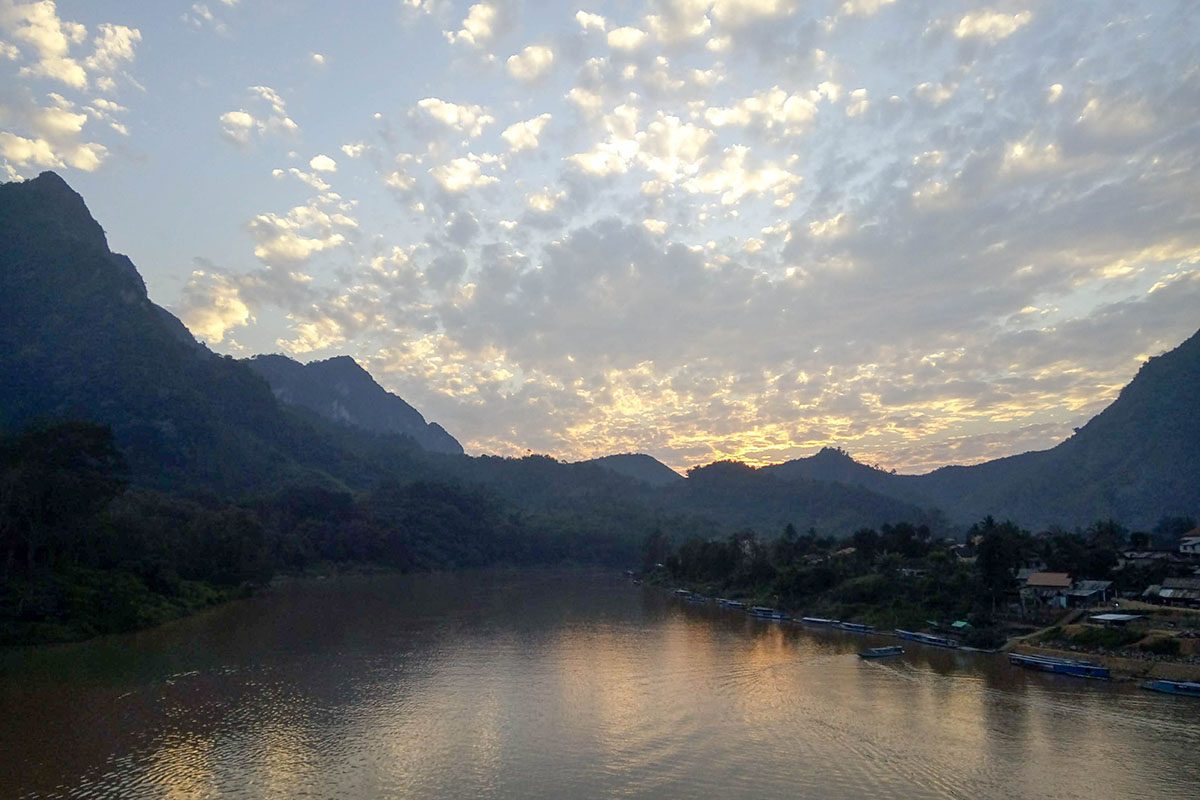
But the best of Nong Khiaw is in the surrounding area.
Take a two-day hike to see some of the spectacular nature of the region, including jungle, rice terraces and local villages. You’ll travel from place to place by boat, hike to waterfalls, and stay in a homestay in a local village. Of course, all food will be authentically Lao and Lao Lao (local whiskey) is included!
These tours are not bookable online, but you can head to the tour operators when you arrive in Nong Khiaw and see which treks they have leaving while you’re in town.
Where to stay in Nong Khiaw
Hostel: there is one hostel called Delilah’s, which also has an attached restaurant serving some of the best food in town. Dorms are very cheap (just 35,000 kip) but they do not take reservations and are often full.
This was the case when I was there, so I haven’t seen the dorms, but the cafe area is nice and pretty chill.
However, a word of warning that I read on Wikitravel was that the boss not actually that nice to his staff – so it’s up to you whether you feel comfortable staying/ eating there. I experienced him not being too pleasant to a waiter while there, which made me feel quite awkward!
Guesthouse: Sythane Guesthouse is decent and a great price. Rooms have their own en-suite with a shower (it’s traditional over-the-toilet like elsewhere in Laos, but it’s ok!), double beds and their own little outside area, some with hammocks. It’s right next to Deen’s Indian Restaurant, a great eatery where I ate basically every day while in Nong Khiaw… #creative. Click here for rates and to book Sythane Guesthouse.
Where to go from Nong Khiaw
From Nong Khiaw, take a bus back to Luang Prabang. From here, you can take a bus to Phonsavan (you will probably need to stay one more night in Luang Prabang). Click here to book your bus tickets.
Phonsavan – 3 days
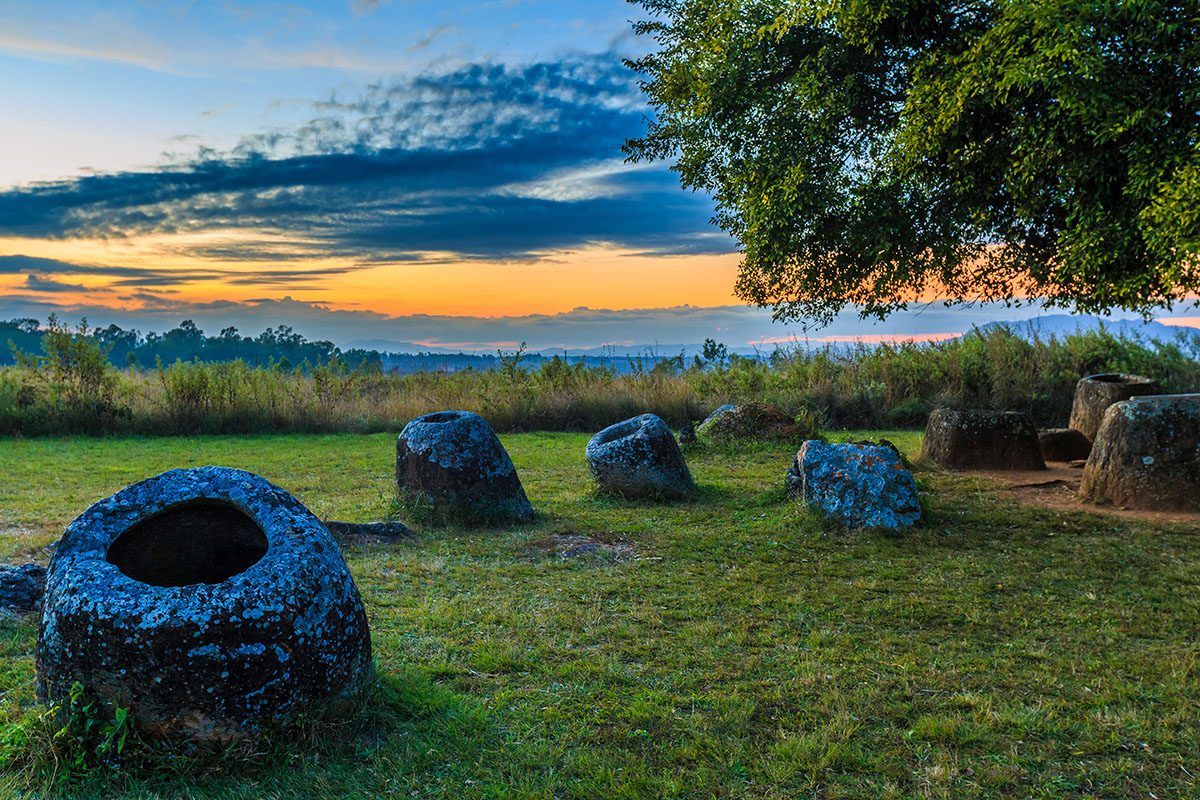
In Phonsavan, there is a grassy expanse which is just full of jars.
Nobody knows how they got there. But there’s jar after jar after jar. It’s wild, and it’s definitely worth the 8+ hour bus trip from Luang Prabang and Vang Vieng. It’s the ‘Strange Plain of Jars‘ (says BBC travel) and while it is very remote, it’s well worth the journey if you have the time.
The urns on the plain date to the iron age, and nobody really knows how they got there or exactly what they were used for. It seems really strange to travel for hundreds of kilometres to check out some stone jars littered around the countryside, but the mystique of it all really adds to the atmosphere. Laos wants to make the Plain of Jars a UNESCO world heritage site, but the area has to be completely cleared of UXOs before this can happen (more on that later).
There are three sites that are accessible from Phonsavan by foot, bike, tuk-tuk or tour. Either rent a motorbike and use maps or join a tour.
The tour will obviously give you lots of historical information, like the leading theory of why the jars are there (spoiler: it’s related to decomposing bodies..). It also includes a few other stops like a whiskey-making shop and a few war exhibitions.
This area was savagely bombed during the Secret War; the bomb craters you see are a sombering reminder of this. But unfortunately, this isn’t something that just existed in the past – bombs exploding are a very real threat to this day.
Make sure that you stay on marked paths which have been cleared, and don’t wander off the trail.
You’re probably saying ‘Claire that’s obviously only one day worth of activities, why have you advised I stay here for three?’. I haven’t. I’ve just factored in the two travel days that it takes to get there and back out to Vang Vieng.
It’s a long ol’ journey, full of twists and turns – maybe not for the faint-hearted, but you’ll experience a side of Laos that many tourists miss out on.
Even though it’s an absolute mission away from anything, I would still recommend visiting the Plain of Jars.
Click here to book a bus from Phonsavan to Vang Vieng
Where to Stay in Phonsavan
Again, there aren’t any hostels in Phonsavan (this is one of the ways that Laos is actually more expensive than Thailand and substantially more than Vietnam to travel, as there is less backpacker-style accommodation. It’s still cheap though, dont’ sweat too much!).
But The Hillside Residence is a good find. The rooms are clean and comfortable – extra touches like well-placed lighting make a difference and give it a more deluxe atmosphere than a lot of Lao guesthouses.
The staff are really friendly and will happily meet you at the bus station. Rooms have balconies and private bathrooms, and the staff are happy to give lots of information about the local area. Click here for rates and to reserve.
Vang Vieng – 2 days
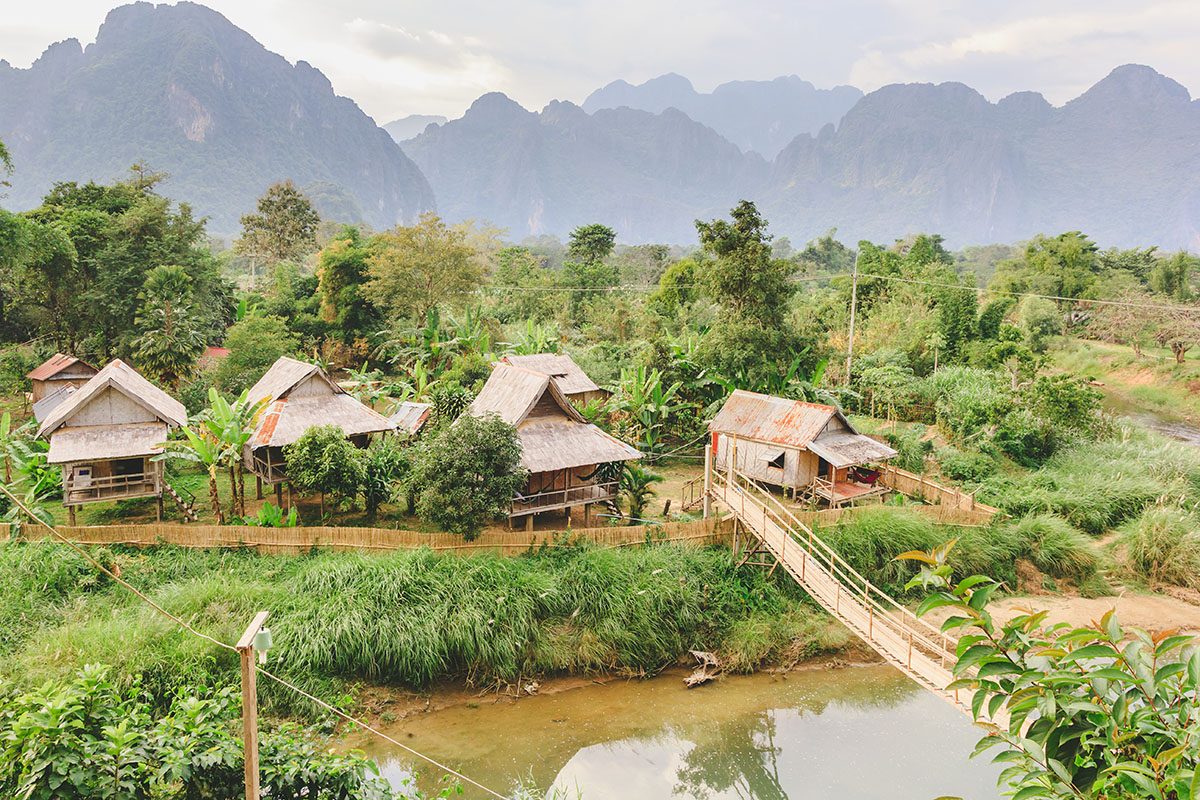
Oh Vang Vieng. What a place.
So bearing in mind I arrived here after spending 3 weeks in Southern Laos, honestly – I just disliked it. The main street has absolutely no culture, bar one temple, and is just full of backpacker bars and restaurants.
I got called boring by a guy wearing leopard print leggings and fluorescent paint because I didn’t want to go inside the bar he was working for. It was just a shambles. Vang Vieng was once the most hedonistic place in Asia.
It was home to infamous tubing, with dozens of bars open on the river, frequented by inebriated backpackers every day. But bad things happened – in one year alone, 27 people died in the river from getting drunk and doing stupid things.
That’s a tragic amount of lives lost due to silly drunk mistakes. It has calmed down a lot now.
Tubing still exists, but there are only 4 bars to drink at these days, and a lot of the areas that cost people their lives have been removed or fenced off.
However, it remains a party town, which is pretty out of touch with Laos. It’s certainly unlike everywhere else I went in Laos.
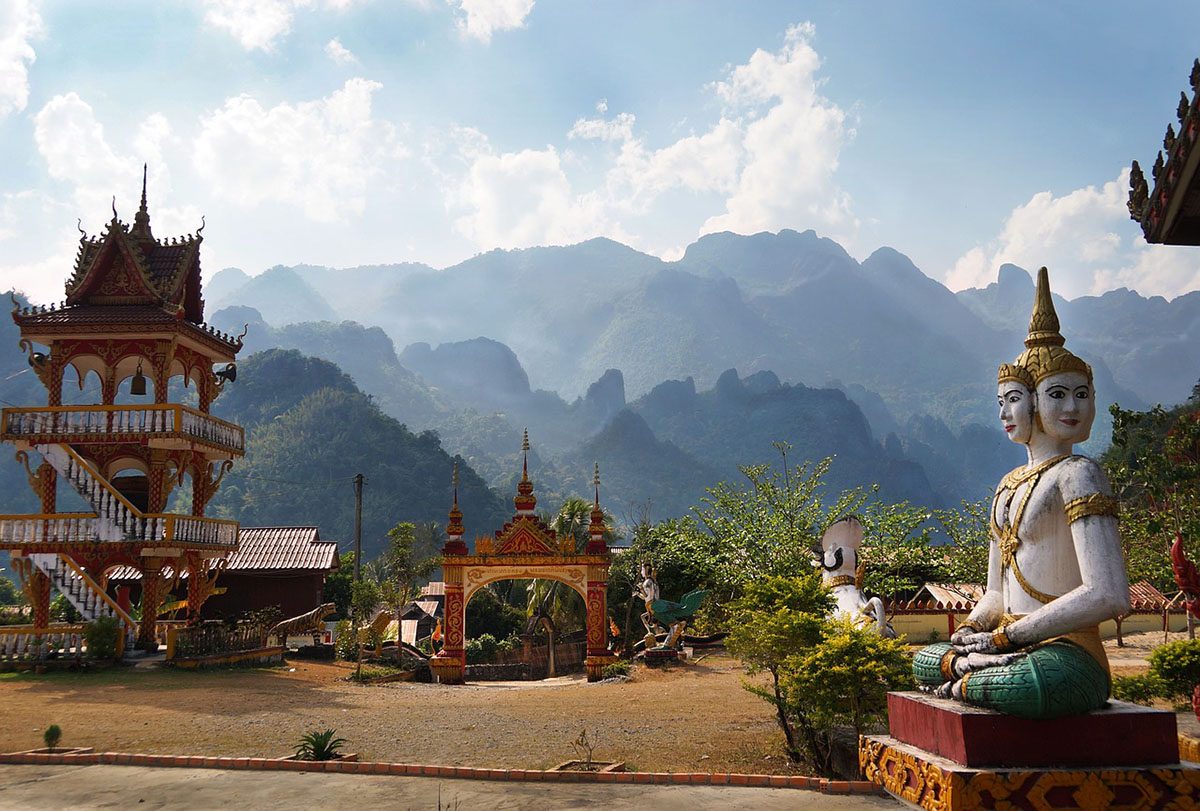
But anyway, the countryside around the town is beautiful. And there are a lot of things to do in Vang Vieng. Plus, I’m not saying that nobody should party in Vang Vieng – but if you do, please be respectful to local culture and don’t be rowdy or do anything offensive.
Even though I really didn’t like Vang Vieng, I do understand its appeal. It’s a place where you can adventure in the day and drink throughout the night, as well as meet dozens of new people. If you’re spending two days in Vang Vieng, one of them will probably be taken up with tubing.
Believe it or not, you don’t have to drink to do this – but if you do, please don’t take it too far. For day number two, I’d recommend hiring a bicycle or motorbike and seeing some of the lookouts and natural phenomena.
The Blue Lagoon is located 7 kilometres from the town and is a great spot to cool off on a hot day. The Pha Ngeun Viewpoint is located on the way to the Blue Lagoon. It takes about 1-1.5 hours to hike up (it’s harder than it looks!) and there are great views of the surrounding nature from the top. Read my post about hiking in Vang Vieng for more information.
If you’re feeling adventurous, you could also check out some of the caves and other activities. Some of the adrenaline-boosting activities you can do in Vang Vieng are:
- A rock climbing course – click here for more information
- Visiting the Tham Nam Cave – click here to learn more
- Kayaking and ziplining – click here to read more about it
Where to Stay in Vang Vieng
I had a really hard time trying to find accommodation in Vang Vieng. Let’s be real, I had a hard time doing anything in Vang Vieng (read my hiking post for more information…)
Hostel – Many backpackers go to Nanas, which is the party hostel. If you fancy that, click here to check it out. I ended up at Jennin Backpackers in a private room, but it wasn’t my favourite hostel. I think the dorms are good value, especially as the rate includes breakfast, but there are definitely cheaper and nicer places to stay in a private room. Click here if you want to check out the dorms.
Mid-Range Hotel – Simon Riverside Hotel is a decent option. With an outdoor pool and garden, as well as views looking out over the mountains, the rooms are all en-suite and are clean, with lots of natural light, balconies and a flat-screen TV. Click here for rates and to reserve.
Luxury Hotel – if you’re after somewhere deluxe in Vang Vieng, Riverside Boutique Resort is a fabulous place to stay. With bright, airy rooms that are decorated in a traditional style yet have modern amenities, you’ll be in the lap of luxury while staying here. Click here for rates and to book.Click here to book a bus from Vang Vieng to Vientiane
Vientiane – 2 days
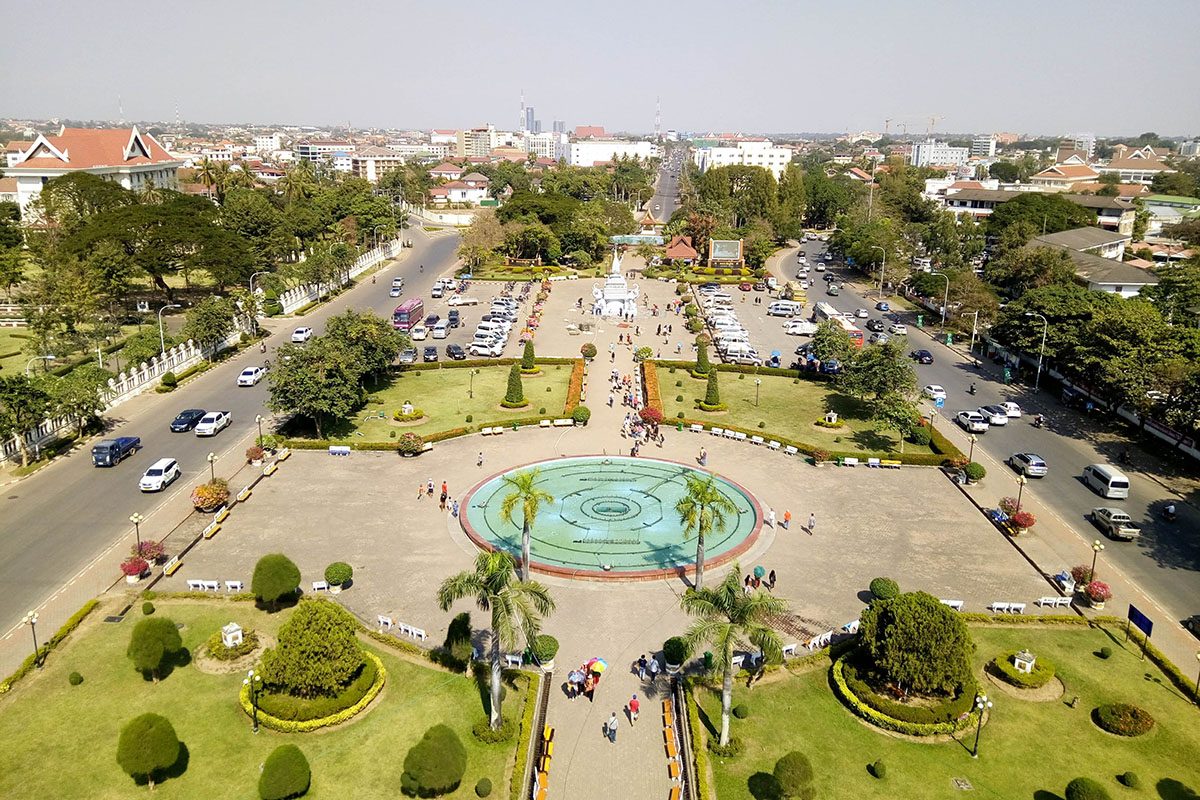
Ok, unpopular opinion, but I loved Vientiane.
It’s just so chill, but with a few different things to do. If you arrive into Vientiane on the morning bus from Vang Vieng, getting there early afternoon, I’d recommend spending afternoon number one at the Buddha Park.
This park is home to Buddha statues in all shapes and sizes, and it overlooks the Mekong and, on the other side, Thailand. It’s a really zen place, playing the most soothing music, and I loved getting lost amongst the statues. You can hire a motorbike to get there or take a local bus for just 8,000 kip.

For dinner, check out Lao kitchen. Serving Lao’s best cuisine but also tailoring it for Western tastes and dietary requirements, it’s one of Vientiane’s best restaurants. If you want to do a full day tour of Buddha Park and learn about some Lao Textiles to boot, check out this tour.
Dedicate your second day in Vientiane to seeing the city. While it does not have as many attractions as most Asian cities, there’s still plenty there to pass some time.
The COPE visitor’s centre should be high on any tourists list – here you can learn about the UXOs in Lao’s countryside and how they still very much affect the population today. (UXOs are unexploded bombs from the US bombing of Laos during the Vietnamese War. There are still many in the countryside and they still explode, killing and maiming civilians, to this day).
Various wats are worth checking out as well. Sisaket Temple, Wat Si Muang and Wat Phra Kaew are in the city centre and all have their own style and history. At Wat Sok Pa Luang, there is a mediation class led by monks every Saturday!
There is also the Patuxai Victory Monument, which looks a lot like the Arc de Triomphe in Paris, but was actually erected in memory of the people who struggled against the French for independence. It can be admired outside and climbed up. If you’d rather see Vientiane on a guided tour, click here to learn more about a cycle tour around the city or here for a car/ van tour of Vientiane’s sights.
Obviously, having a guide means that you’ll pick up invaluable information about the capital’s culture and history, so it’s a great idea to do one of these tours while in the city!
At night, hit up the market. There are plenty of stalls selling all sorts of food, as well as souvenirs and crafts.
And it’s set over the Mekong, where you can gaze over at Thailand. I ended up doing this so much on my Laos itinerary (again in Thakhek and Savannakhet) that I started to feel a bit creepy. Sorry Thailand.
Where to Stay in Vientiane
Hostel: Don’t stay anywhere other than My Box Hostel. It literally is the best hostel I have ever stayed in – I absolutely bladdy loved it here. Each bunk bed has its own ‘pod’ with thick curtains (so you actually can’t see outside lights), individual lights and plugs, super comfy mattresses and nice warm showers. There’s a good free breakfast on offer, plus a coffee shop. It’s not a party place, but it’s absolutely 10/10 lovely. Click here for more details and to book (do it).
Mid-Range Hotel: Vientiane Garden Boutique Hotel is a great price, with clean, classy and comfortable rooms. All have their own en-suite with hot shower and there is an outdoor pool. Click here for more information and to book your room.
Luxury Hotel: For 5* luxury, check out Muong Thanh Luxury Vientiane which is located just a short drive from the city. Guests at this hotel can enjoy staying in spacious suites with plush velvet furniture, huge beds and breathaking views across the cityscape. On site are tennis courts, a spa and an outdoor pool. Click here for more information and to book your room.
Where to go from Vientiane
Click here to book a bus from Vientiane to Kong Lor (this will involve transferring to a songthaew for the last part of the journey – just make it very obvious that you’re going to Kong Lor and you’ll be directed through the change over).
Kong Lor – 2 days

Note: if you are planning on doing the Thakhek motorbike loop from Thakhek city, you don’t need to stop in Kong Lor on the way as the loop includes it. If you cannot ride a motorbike, don’t try it for the first time here. You can still see Kong Lor Cave by public transport.
Get a bus from Vientiane to Kong Lor in the morning. If you’re in a rush, you can see Kong Lor Cave that very afternoon; it doesn’t take long to explore. You’ll need to walk to the park entrance and pay 100,000 kip per boat.
Then a guide will take you through the cave (you’ll be on the boat for most of the way but will walk a little) and out the other side to a small village.
After a stop here, you’ll get to travel back through the cave and out to the other side, where you can swim or just relax and take in the nature.

If you have more time on your hands, consider a hiking trip in the mountains of Kong Lor. These can be arranged through your guesthouse.
Where to Stay in Kong Lor
Hostel/ Guesthouse: Thongdam Guesthouse has private and dorm rooms – dorm rooms are set in cute little cabins, nestled into the surrounding hills, while the private rooms are in the main building and have their own bathroom. It’s great value and there is a restaurant across the road. It’s just a 15 minute walk from here to Kong Lor Cave and the songthaew will pick you up/ drop you off right outside.Click here for rates and to book.
Luxury Hotel: The Kongloview Hotel has self-contained, well furnished cabins with their own bathroom including a spacious shower. There is a bar on site and breakfast is available, and it is located right next to the Kong Lor Cave. Click here for more information and to read reviews.
From Kong Lor to Thakhek, you’ll need to get a songthaew. You can pick these up from the main road of the village (it’s pretty self-explanatory when you’re there, there’s only one road that runs through Kong Lor).
Thakhek – 2-4 days
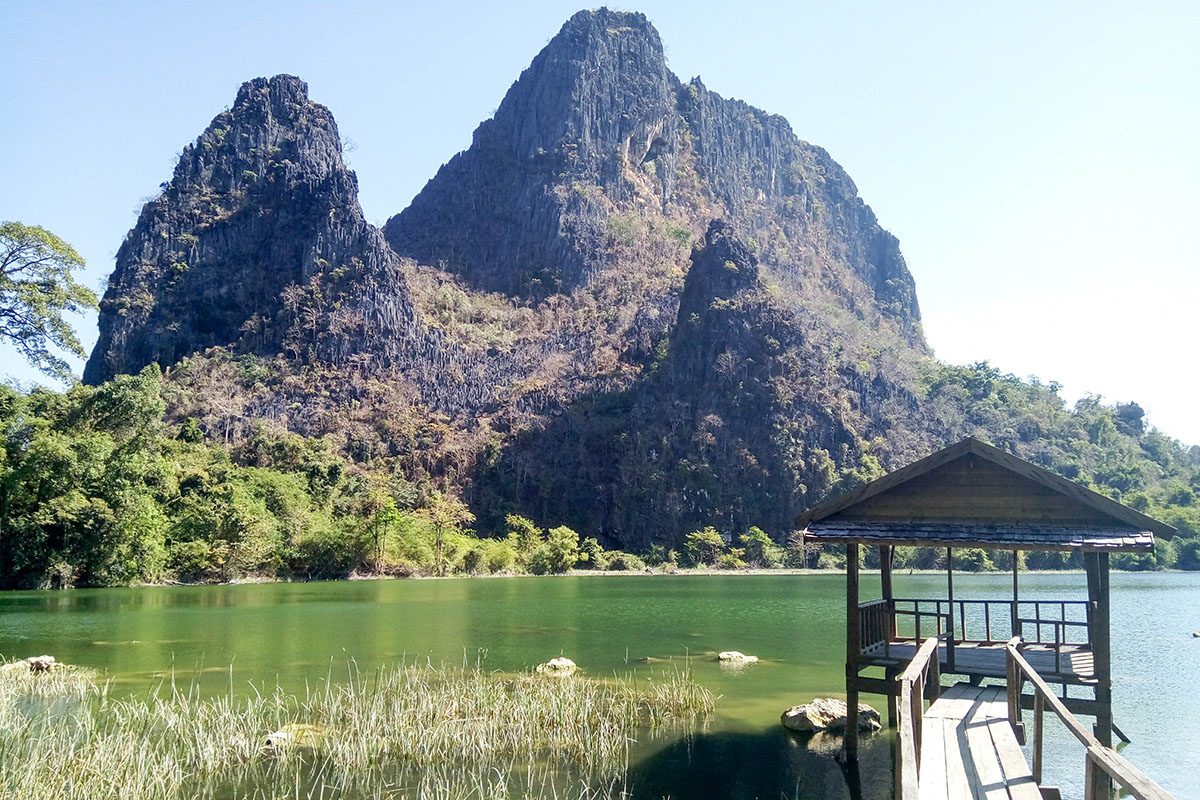
Six hours south of Vientiane, or five hours from Kong Lor on a bumpy songthaew is Thakhek, a small city that’s home to the Thakhek Loop.
There isn’t much to do in the city itself, but you could spend your first afternoon there walking along the Mekong, getting a massage and checking out the night market.
A great dinner spot is Song Fang Khong (being the adventurous soul I am, I ate here three times in two days while in Thakhek).
The next day – if you’re down for it, can ride a bike, or have friends who can ride a bike – take on the loop. This three-day loop is one of South East Asia’s best motorcycle adventures.
Day number one includes the caves in the Thakhek area. If you fancy it, you could do a half day or full day’s climbing at Green Climber’s Home as well.
This needs to be booked in advance, and there is accommodation on site but it books up quickly.
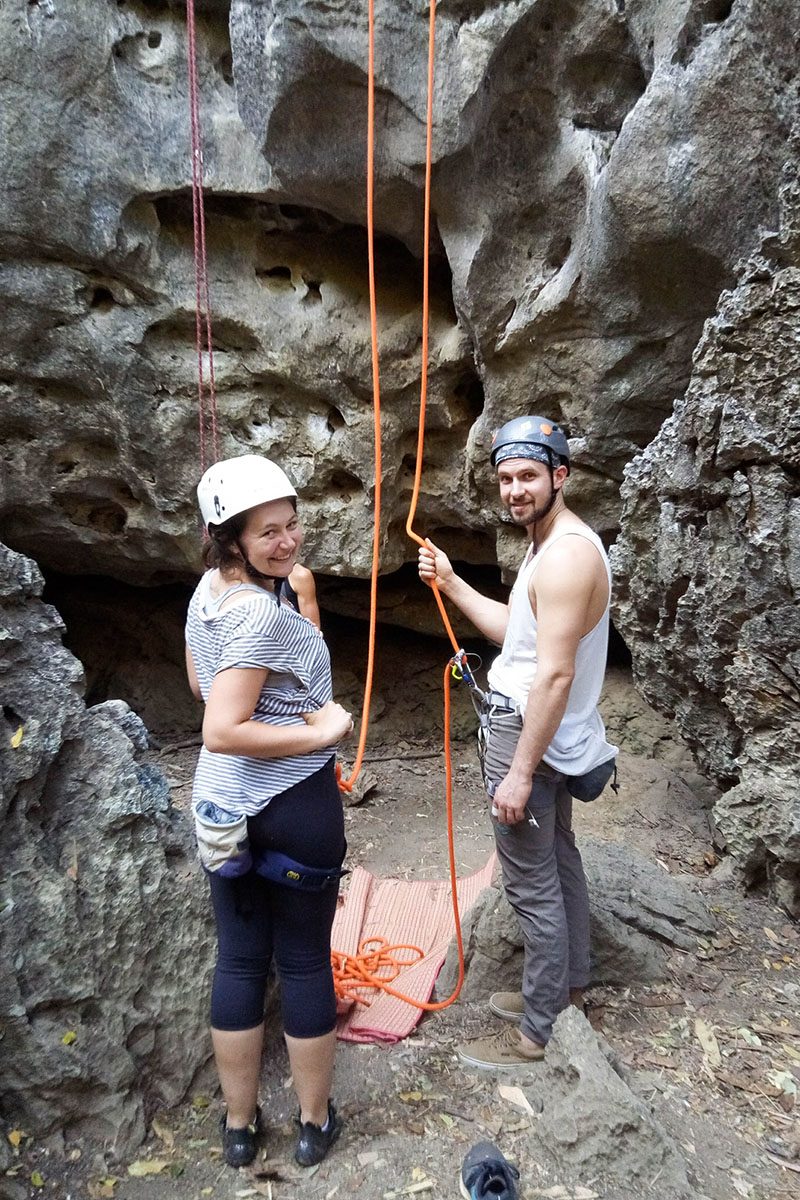
Otherwise, the highlight of the first day is generally Tham Ene Cave. This is a large cavern which offers guided tours. There are plenty of other spots to stop at, photograph and explore, as well.
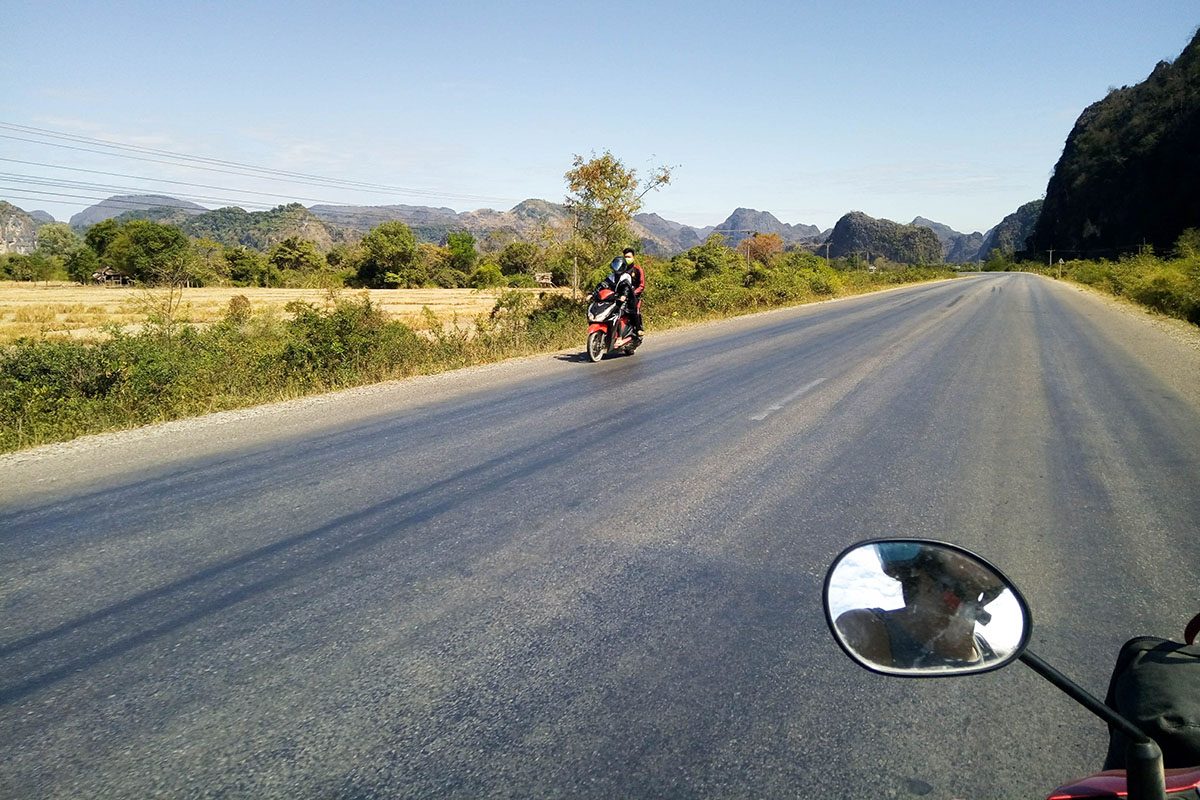
The next day is the drive to Kong Lor, which can be more than hazardous as some of the roads are barely passable!
However, there are still more of those absolutely epic views, making it well worth it. Once you arrive at Kong Lor, you’ll get the chance to really embrace the rural surroundings of it. Day three is about exploring Kong Lor Cave (see above) and then heading back to Thakhek!
Where to Stay in Thakhek
Hostel: Bike & Bed is probably the most popular backpacker hangout in Thakhek. It has basic but comfy dorms with spacious, sturdy beds. There are hot showers on the property and the cleanliness standards are impeccable. Bike hire is available from the hostel and free tea, coffee and fruit are provided. Click here for rates and to reserve.
Mid-Range Hotel: Set in quiet garden surroundings, Villa Thakhek has air-conditioned rooms with free WiFi. Each room has a private bathroom and tasty food is available on site. Click here for rates and book.
Luxury Hotel: Le Bouton D’or Boutique Hotel harks back to colonial days with its period decor. It is located right by the river int he heart of Thakhek, and has a bar and breakfast. Click here for more information and to book.To book a bus from Thakhek to Savannakhet, click here.
Savannakhet – 1 day
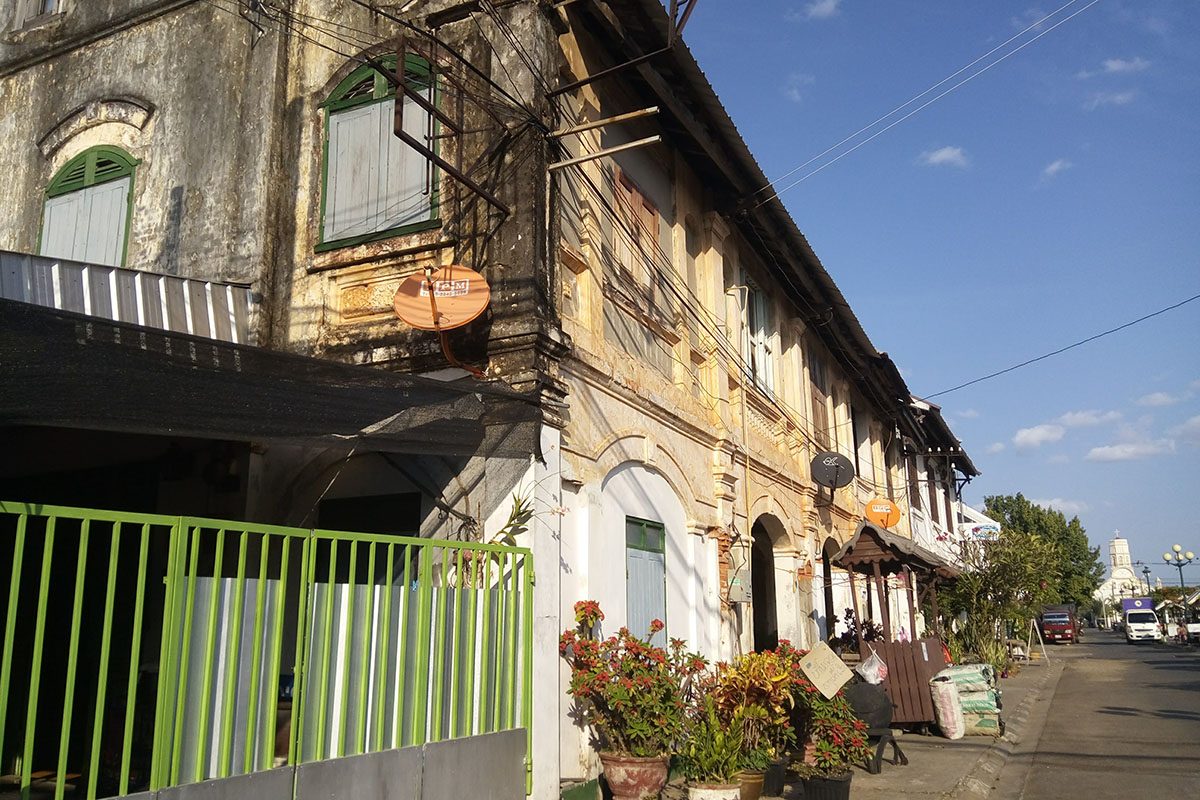
Just three hours south of Thakhek is Savannakhet, a chilled-out colonial town that’s the gateway to southern Laos.
You only really need one day here – there are a couple of museums, temples, a very good night market with great food and Mekong sunsets.
It’s pretty similar to Thakhek in the north, and isn’t an absolute must-do stopover, but it’s quite pleasant nonetheless.
Read my blog post about the best things to do in Savannakhet here.
Where to Stay in Savannakhet
Guesthouse: There are no hostels in Savannakhet, but Sala Thongyon Guesthouse is cheap and a lovely quiet place to stay (can you see a trend of all the places I like yet?!). It’s set in a garden atmosphere, contrasting to the city. You can hire a bike from here to explore the surroundings, the WiFi is decent, the rooms are cosy and rustic and have their own shower with hot water. Click here to learn more.
Luxury Hotel: Avalon Residence is about as luxury you’re going to get in Savannakhet. It’s a 3* hotel, with modest yet nice rooms with comfy beds, satellite TVs and bathrooms with separate showers. Click here for rates and book today.To book buses from Savannakhet to Pakse, click here.
Pakse – 1 day

Congratulations at making it to Pakse, Laos’ most southern city (and the only place you’ll find an ATM before Siem Reap in Cambodia).
The first thing you’ll notice is that Paske is H.O.T – it’s like a furnace. If you take a morning bus from Savannakhet, you’ll reach Pakse by early to midafternoon.
This is perfect for a stroll around the city, which is pleasant in its own way but not up to much. The most popular attraction is the Big Buddha, who sits atop the hill and gazes at the city and plateaus. You can rent a bike to drive up there, or take a tuk tuk for about 50,000 kip.
It’s got a view over the whole city, and quite a staggering 360 vista as the sun goes down. Laos is home to some incredible sunsets, and Pakse is no exception. Other attractions in Pakse include the Champasak Provincial Museum and various Wats, which you can find while exploring the city centre.
Where to Stay in Pakse
Hostel: Chato Hostel is one of my favourite hostels in South East Asia. It’s got spacious dorms, with thick curtains blocking out light and sturdy beds, kind of ‘pod’ style. Dorms have their own attached bathroom, which has a warm shower. The staff are really friendly and helpful and there is a microwave and fridge that guests can use, as well as food available to be purchased. It’s right in the centre of Pakse. Click here to learn more and to book.
Mid-Range Hotel: Intouch Riverside Hotel is a great place to stay if you want a slice of luxury without breaking the bank. The rooms are spacious and have en-suite bathrooms with separate showers. Rooms are clean and there is an open-air swimming pool. Click here to make a reservation.
Luxury Hotel: Le Jardin Hotel is perfect for those who want to live in luxury while in Pakse. Decorated with classy red wallpaper and furnishings, and offering a swimming pool and breakfast facilities, this hotel has everything you coul d want in upmarket accommodation. Click here for rates and to book.
Bolevan Plateau – 3-5 days
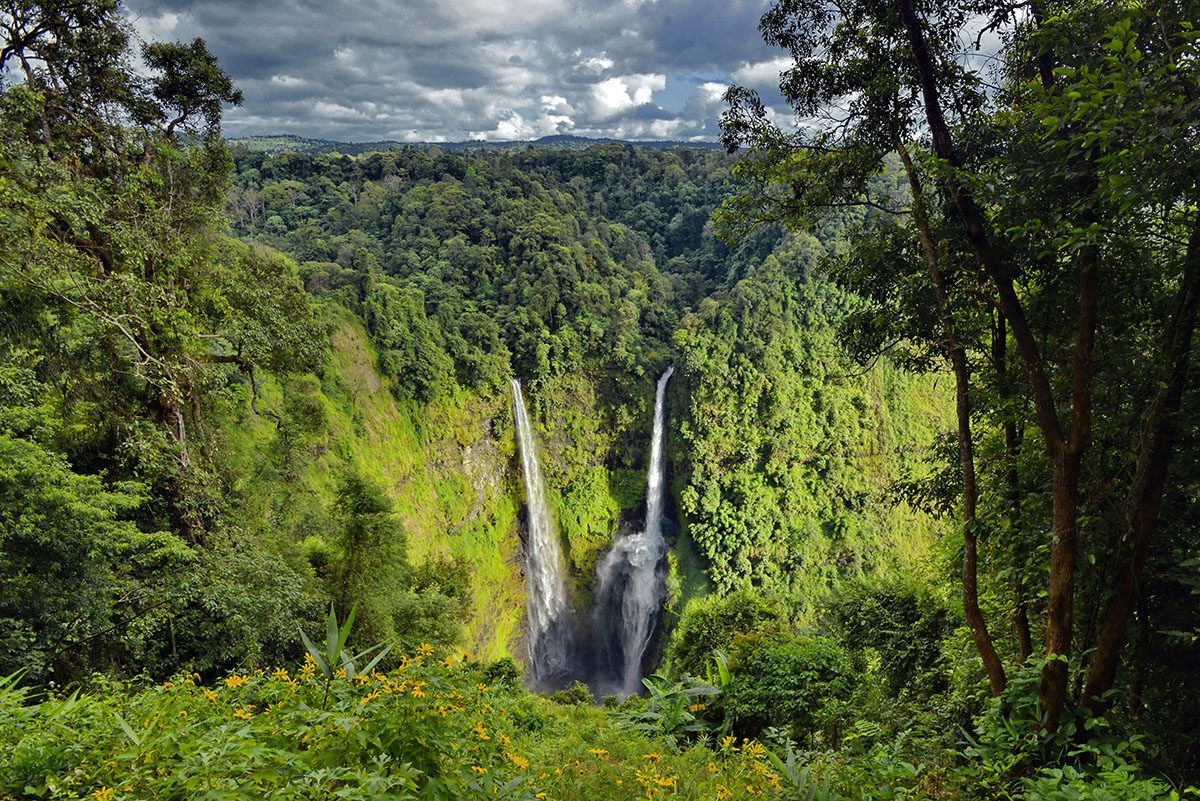
As mentioned before, I cannot ride a scooter and I’m terrified to try. So I didn’t actually do the motorbike loop – although I visited Miss Noy’s, the main scooter rental shop for travelers – and got all the information, just for you guys. I did, however, see the Bolevan Plateau on a guided tour. This included the main waterfalls, coffee plantations, a local homestay with delicious food, a jungle trek, and transfers to and from Pakse. The guide had great English and was very knowledgeable – it was more like hiking with a friend than a guide.
I also did encounter some people in a tuk tuk going around the main sites of the Bolevan Plateau. I’m really not sure how a tuk tuk got up there, but it may be possible.
If you don’t want to pay for a tour and can’t ride a bike, it’s worth an ask I guess?!
The motorbike loop, however, remains the most popular way to see the Bolevan Plateau and for good reason; the scenes are incredible, there are local homestays to stay at, there’s plenty of places to stop off and you go completely at your own pace.
You can spend anywhere from 2 to 5 days on the loop (there’s a short one and a long one), enjoying waterfalls, hiking, local villages and more. For the best information about the motorbike loop, head to Miss Noy’s who will tell you all you need to know.
Where to Stay on the Bolevan Plateau
Guesthouses on the Boleavan Plateau tend to just take walk ins only, and they will generally have space. If you go to Miss Noy’s presentation, they will give you all the information you need! From the Bolevan Plateau, you will need to return to Champasak to take onward travel. To book a bus from Pakse to Champasak, click here.
Champasak – 1 day
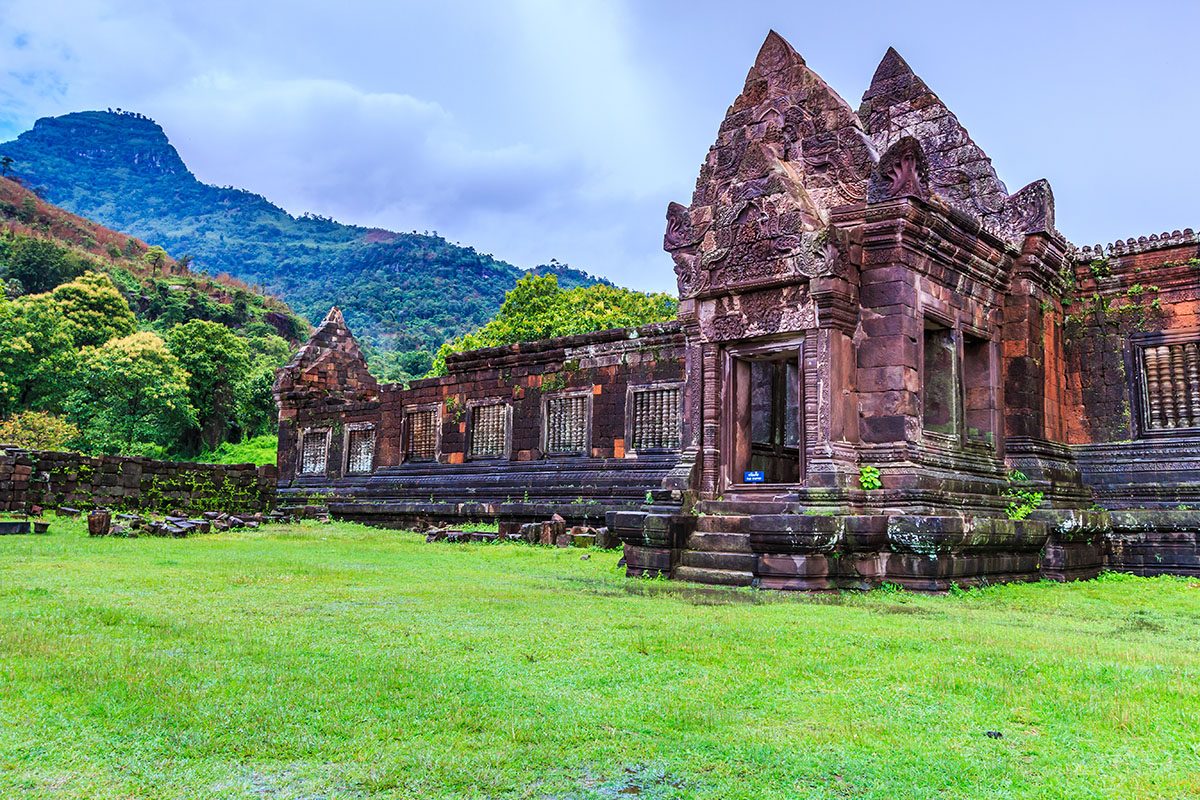
Just an hour or so south of Pakse is the charming town of Champasak.
It’s a lot more visually appealing than Pakse, with run down streets, riverside stalls and bicycle trails. Spending a day here will enable you to visit Vat Phu, which is an impressive set of ruins somewhat similar to Angkor Wat (but still well worth seeing if you have already been/ are planning on going to its more famous Cambodian cousins).
It is also possible to do Champasak as a day trip from Pakse by renting a bike or taking a tuk tuk. But if you’re heading south anyway, you may as well take the bus and stay there for a night!
Where to Stay in Champasak
Guesthouse: Kamphouy Guesthouse is a quiet, clean and comfortable guesthouse, with an owner who speaks great English and is very helpful about travel around Laos. It is located right next to the bus stop andhas good WiFi. Rooms are basic but adequate for a value stay. Click here for rates and to book.
Hotel: Nakorn Riverview has a classy eastern feel, with ornate archtiecture and beautiful decor. It overlooks the beautiful river and has an on-site bar. Rooms enjoy an en-suite with separate shower and comfy beds. Click here for rates and to book.Click here for transport from Champasak to the 4,000 islands
4,000 islands (Si Phan Don) – 3 days
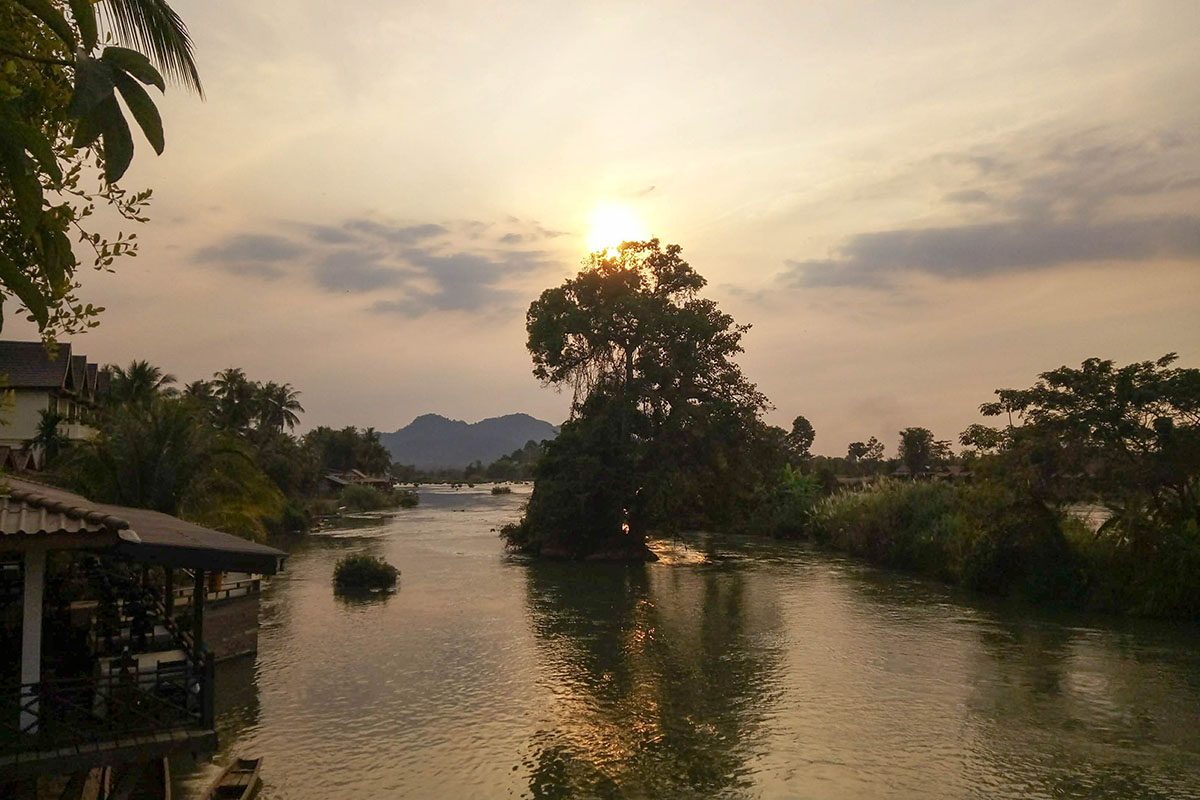
Yep, the landlocked country of Laos has not just one island, but 4,000 (give or take, nobody’s sure of the exact number).
Our good friend, the Mekong, delivers again with these chilled out land masses that wouldn’t be out of place in Thailand’s Andaman sea.
While there are literally thousands of islands, only three of them are inhabitable; and the huge majority of visitors stick to Don Det.
Don Det kind of tries to be a party island, but it doesn’t really work – but it’s still very nice!
Don Khon is a lot more local and chilled out. I’d recommend spending two days in the 4,000 islands. Day number one can be spent just cycling around, enjoying the views of the Mekong and taking in local life. There are plenty of great places to eat in Don Det, and quite a few in Don Khon.
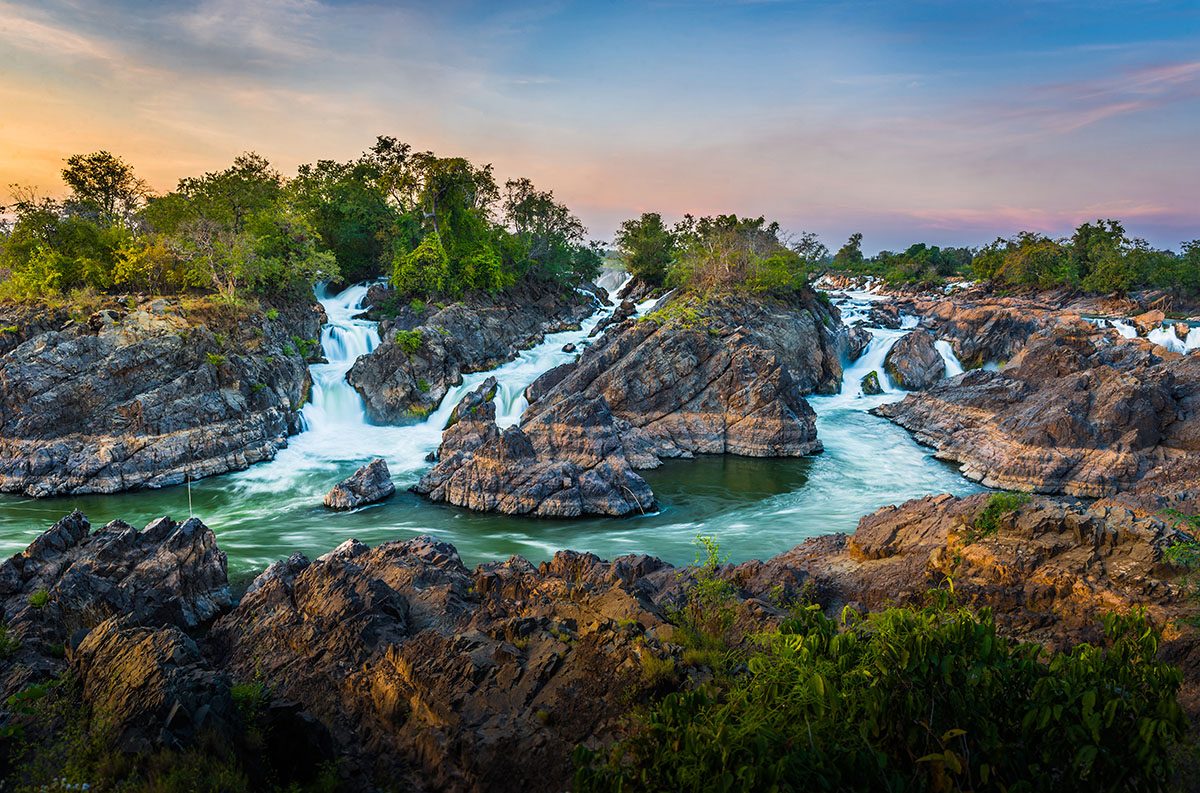
Visit the waterfalls of Don Khon, as well as lookouts on both islands. You can even enjoy the beach and apparently, you can swim in the Mekong – I can’t say I fancied it though.

Day number two should be spent doing a kayaking tour to try and find the endangered Irwaddy River Dolphins. Southern Laos is the only place in the world that you’ll see these creatures; which hopefully you’ll get the chance to! You’ll also head over to the mainland where you can see Khon Phapheng Falls, the largest waterfall in South East Asia.
Where to Stay in Si Phan Don
Hostel: For a budget stay with a difference, The Last Resort offers tipi style acommodation. Tipis are very basic but still very nice, with electricity, a comfy bed and a mosquito net. It’s probably not the place for anyone who doesn’t like bugs, but it’s a great glamping-style experience. Click here to learn more information.
Mid-Range Hotel: Champa Mekong Bungalows has a lovely restaurant over the river, where you can enjoy dinner and a gorgeous Don Det sunset. Rooms are basic but comfy, with double beds and private bathrooms. Click here for rates and to reserve.
Luxury Hotel: Little Eden Hotel is probably the most luxurious place to stay in Si Phan Don. It has a great swimming pool, which is welcomed in Don Det – it’s hot here – as well as stylish, airy and spacious rooms. Breakfast is included in the room rate. Click here for rates and to book.
Where to go from Si Phan Don
From Don Det, you can book a transfer to Siem Reap, ready for your Cambodia explorations!
Or, if you’re just sticking to Laos, you’ll need to head back up to Pakse where you can find onwards travel (it costs $30 to enter Cambodia for any amount of time, so it’s best to get onward transport to Thailand or Vietnam from Pakse if you’re not planning on seeing Cambodia).
If you’re searching for a lively hostel in Siem Reap, check out my review of Mad Monkey Siem Reap. Booking onward travel? You can use Bookaway to reserve all your buses in Laos.
What to Pack for Laos
Laos is generally warm all year round, although some places in the mountainous north do have a cold snap in the winter – and in many places, including the northern mountains and the Bolevan Plateau, it can get cold at night.So what should you pack for Laos? Clothing wise, you’ll probably need…
- Hiking boots and gear for the many treks in the country
- Something a little warmer in case you get cold days in the mountains
- A swimsuit for the many waterfalls
- Comfy shoes for walking around the towns
- A rain jacket if you’re visiting during the rainy season
- Long trousers and cover-ups for temples
- A badass style sense like the following fashonista…

And for gear, I’d recommend including…
- A Laos guidebook – this will be very helpful when you’re exploring all the different attractions.
.
.
Being Respectful in Laos
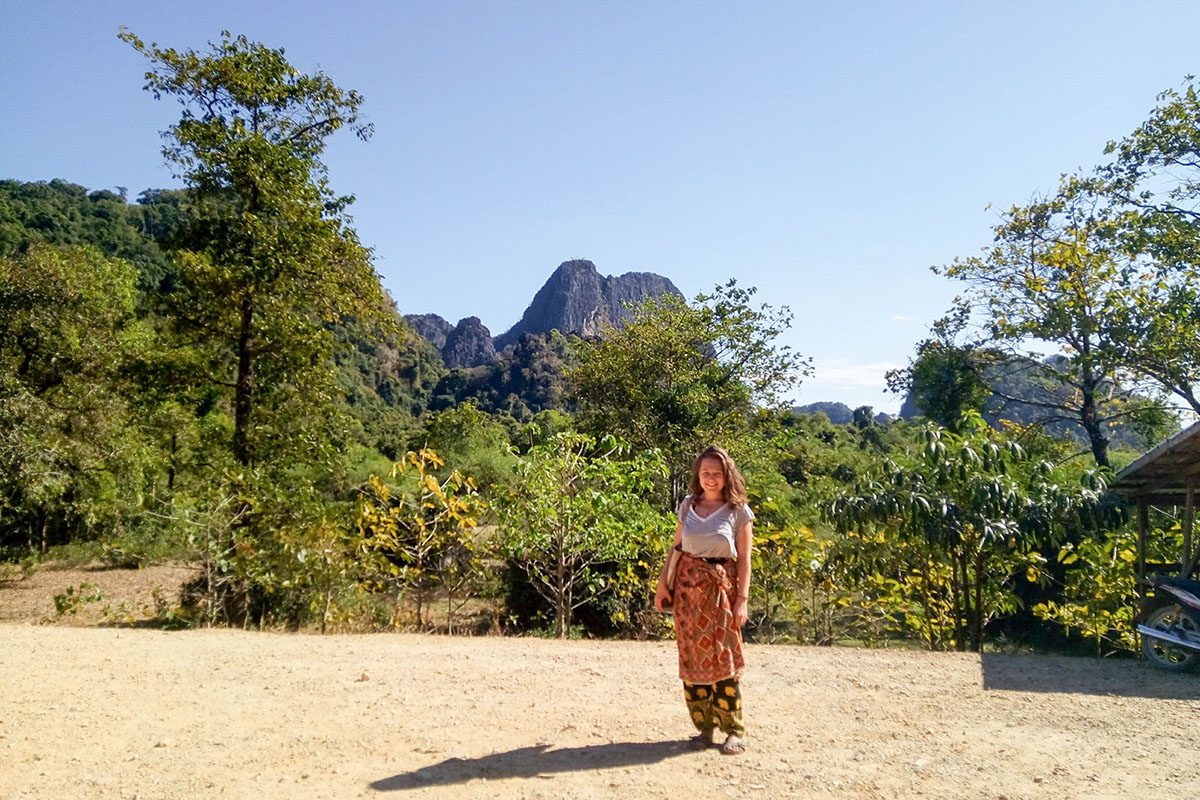
I could probably sit here for a couple of days talking about this, but I’m guessing that you probably have other things to do than read about me ranting about drunk idiots in Vang Vieng.
So I’ll keep it fairly short: Laos has been through a lot in the last century. It’s not as commonly known, but the Vietnamese War also took place in Laos. Here, it was called ‘the Secret War‘ but for the people of this country, it was anything but secret.
So many bombs were dropped on the country that wasn’t even involved in this war, that it has become the most bombed country of all time. The US dropped 270 million bombs on the country during the Vietnamese War.

Many people died during these raids, but over a thrid of bombs didn’t explode. This means that UXOs (unexploded ordanance) litter the Lao countryside to this day. They are still being cleared and people still die from these bombs exploding today. Laos is a developing country, and tourism only became unrestricted there in the 1990s.
Nowadays, tourism is one of the most important economies in the country, so if we’re doing it right, us being there can help Laos and its people. Key phrase – if we’re doing it right.
I’m not saying don’t go to Vang Vieng, or even don’t go tubing in Vang Vieng. But I’m saying that Vang Vieng’s life as a hedonistic paradise/ hell-hole (depending which way you look at it) wasn’t the kind of tourism that Laos needs.
This Guardian article gives a thorough perspective on it from a Lao point of view: how their “traditional way of living has been eaten alive”, how parents would dread that their sons would find “work by the river” and get sucked into the party atmosphere, how Lao people were having to deal with the dead bodies of tourists who took it too far.
Vang Vieng is different now, but there is still a lot of emphasis on partying. And being here made me wonder – does this have any benefit on locals? Are any of these businesses locally owned? Is it beneficial for the staff to be working here?
One thing I know is that every Lao person I met outside of Vang Vieng seemed much happier than those in Vang Vieng.
And don’t get me started on the drugs – they’re illegal in Laos, guys. Like very illegal.
Even if you don’t care about taking the risk, should we really be buying drugs off locals who are doing an illegal line of work because of tourist demand?! Or should we be supporting local businesses, helping them grow and employ more locals? You vote with your Laos kip. Please don’t vote to support the drug industry.
I’m not saying that you need to be a martyr to travel in Laos, but just do be considerate to Laos’ traditions and way of life.
Respect their conservative culture, if you want to drink don’t be that idiot falling around on the street. Try not to get involved in any in-your-face backpacker bar crawls that you can guarantee local people would hate to see, and understand that things aren’t going to be the same as they are at home.
Support local businesses, buy fruit from local vendors, stay in homestays. These all give monetary benefit to the people of Laos working in tourism. But more than anything, get to know the people. Lao people are lovely, will want to know all about you and your life, and will be really happy that you’re in their country.
Be a tourist that Lao people want to have.
Due to language barriers and the fact that a lot of Lao people stilll work in agricultural industries which don’t see many tourists, it can be difficult to interact with locals.
But do what you can: stay in homestays, speak to your tour guides as much as possible, spark up conversations with wait staff.
Also, try and learn a little about Laos culture and history – including its not so nice past. Having an all-round understanding of this country will really help you be a more responsible traveller in Laos.
Useful Lao Phrases
Lao is very different to European languages, and it’s not expected to even know a little when travelling in Laos.
But if you learn some basic words and phrases, I can guarantee that the locals be incredibly grateful. It’s also a lifesaver outside of touristy spots where most people don’t speak English! See below for some basic phrases…
| Word in English | Written Word in Lao | Pronounciation in Lao |
|---|---|---|
| hello thank you please sorry how much is this station airport bus station one room for one nightrice vegetables beer | ສະບາຍດີ ຂອບໃຈ ກະລຸນາ ຂໍໂທດ ນີ້ລາຄາເທົ່າໃດ ສະຖານີ ສະຫນາມບິນ ສະຖານີລົດເມ ຫນຶ່ງຫ້ອງສໍາລັບຫນຶ່ງໃນຕອນກາງຄືນເຂົ້າ ຜັກ ເບຍ | sabaidee khobchai kaluna khoothd ni la kha theoadai sathani sa nambin sa tha ni lodme nung hong soalab nungnaitonkangkhun khao phak bia |
Books to Read About Laos

- Culture Shock! Laos: A Survival Guide to Customs and Etiquette is the must read guide to Lao culture, how it differs from its neighbours and how to act around Lao people. It’s essential reading to be that responsible tourist in Laos I was talking about…
.
Your Perfect Laos Itinerary!
That’s a wrap, and I’ve just succeeded in writing another post that was longer than my dissertation.
I hope this is a fantastic resource when planning your Laos itinerary! If you’ve enjoyed this post – you know what to do.
Share it far and wide with any other travellers in Laos, and follow me on Instagram and Facebook.
Pin Me!
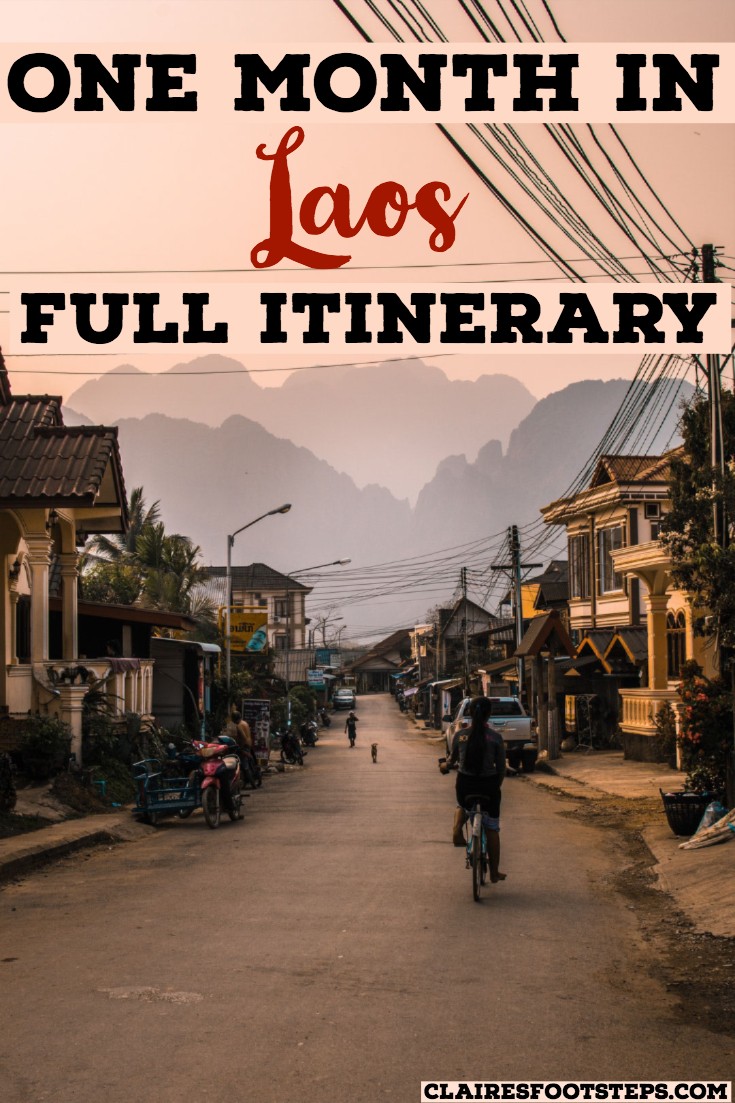

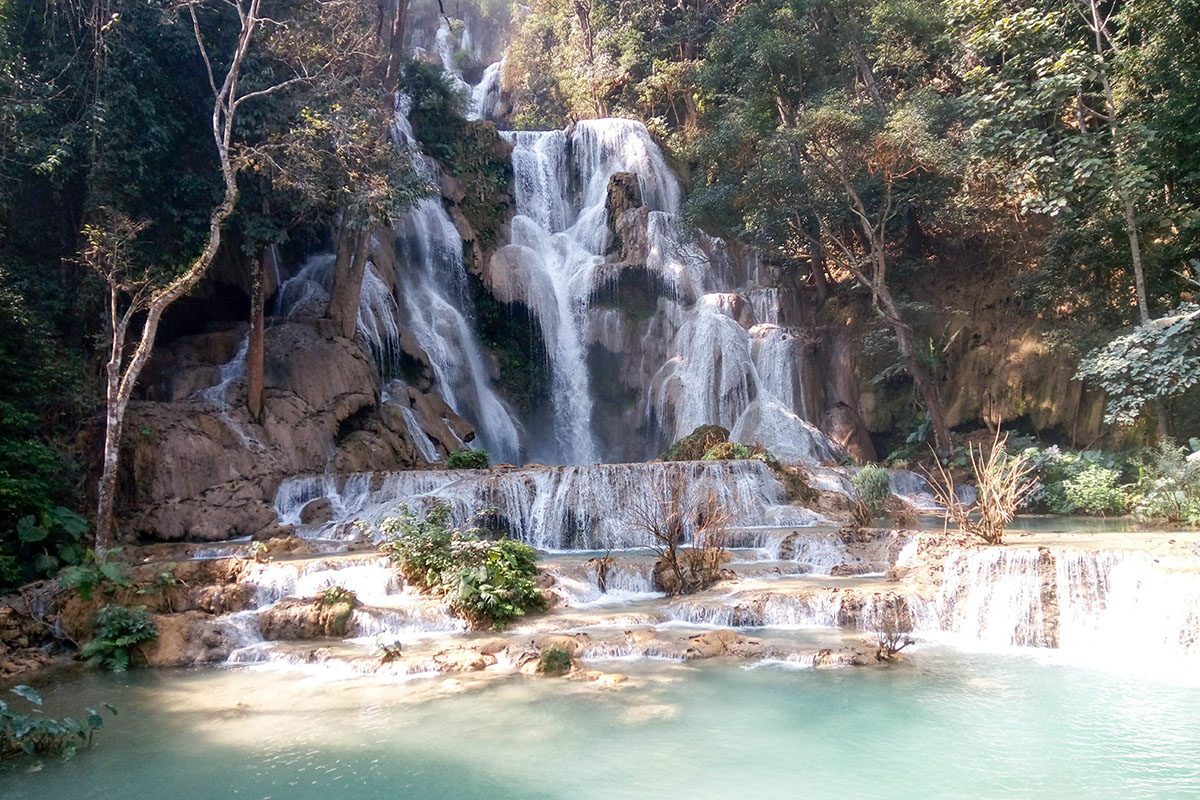
Thank you for all this detailed information. It’s been really helpful.
Greetings from Peru
We are starting our 4 weeks laos from tomorrow and your program is sure important template for us.
We also love and support ethenic and traditional tourism and feel locals should always love to welcome tourism. Such wonderfully well written blog. Thanks clair
Great post Claire
I’m hoping to travel around by bicycle but find it confusing to see if I can rent bikes from Ventiane where I would probably arrive. I see some suggest getting fitted out in Thailand and bringing one’s bike across from there.
Do you have any advice on the subject?
Hi Claire!
I read your Laos story just before heading here after Thailand. We had already planned a brief route – south from Luang Prabang but I just fancied a read at what other trails people tend to do.
(Currently in Vientiane and loving Laos) 🙂
I basically just wanted to say that I, sadly, 110% agree with you about Vang Vieng 🙁
We had done the trekking / caves/ waterfalls already in Luang Prabang and so other than tubing, which we didn’t fancy anyway, there was nothing for us to do. After being so spoilt in LP with all of the lovely food options too, it was such a huge letdown! (We also got funny looks because we didn’t take up drink offers on the street – you’re not the only one who should feel old!)
We did have a fantastic Lao meal at the Riverside boutique hotel restaurant which I would definitely recommend to anyone who would rather spend more on food than booze!
I enjoyed reading your page anyway, take care and enjoy your future travels! 🙂
Thanks Rachel! Yeah Vang Vieng is pretty nasty, the rest of Laos makes up for it though! Did you go to Nong Khiaw? I loved it there! Safe travels 🙂
Totally agree with JD. We are back to LP again but this time via mekong two day cruise from N. Thailand. Now is probably the time to visit Laos (but easily miss Vientiane ) before tourist explosion. Save Vietnam for seperate visit.
Hi! Great blog and super helpful for a solo traveller! Just to let you/travellers know if you go to the right places you can get a night bus from Pakse to Vientiane for a measly 150,000kip (I bought from Miss Noy bike rentals in Pakse) – not sure if it’s more expensive north to south!
Thanks for the updated information!